Sanyo Electric Co CPE-400-270 W-CDMA subscriber terminal User Manual cover front eps
Sanyo Electric Co Ltd W-CDMA subscriber terminal cover front eps
Contents
- 1. Manual
- 2. Quick Setup guide
Manual
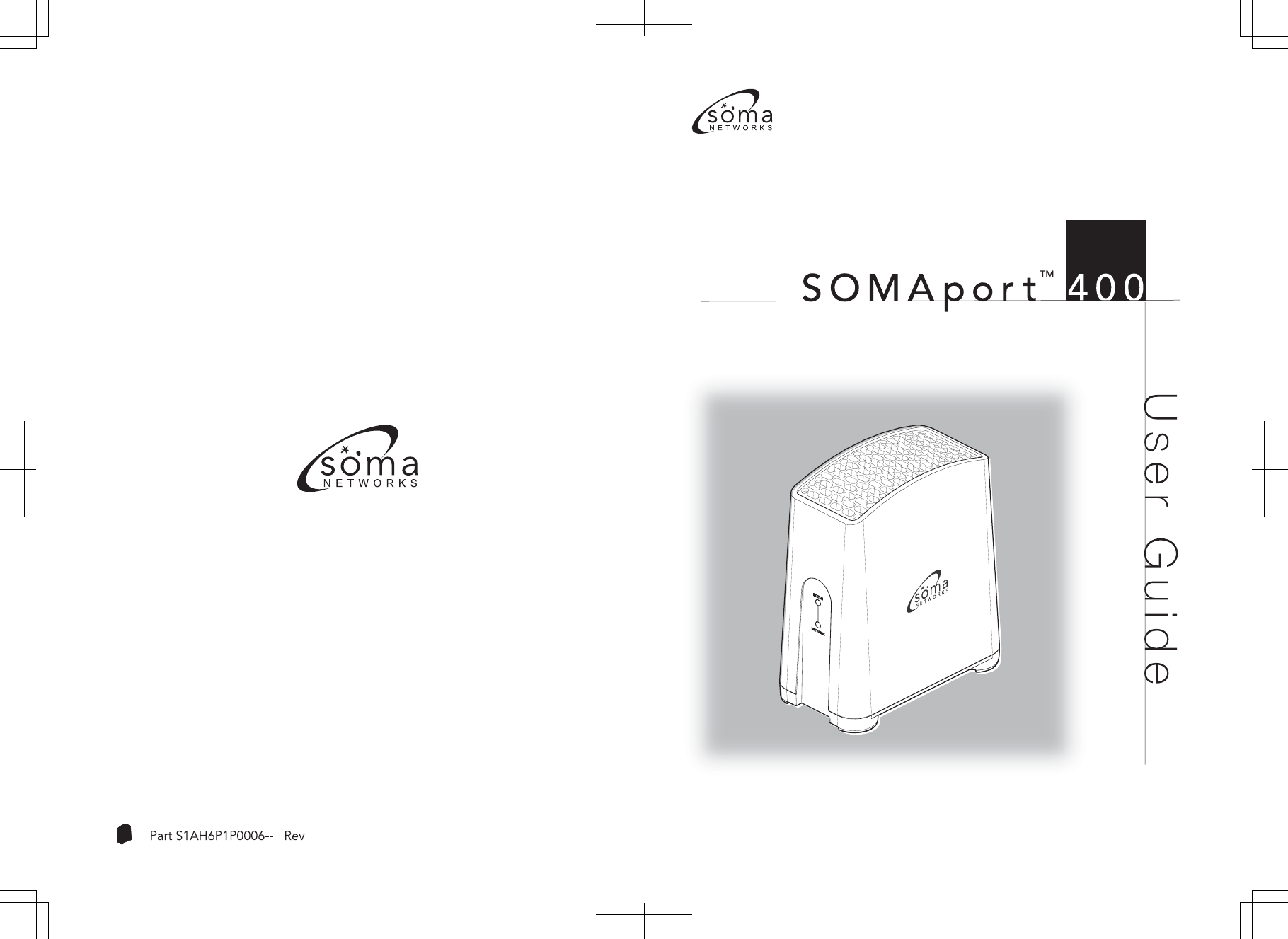
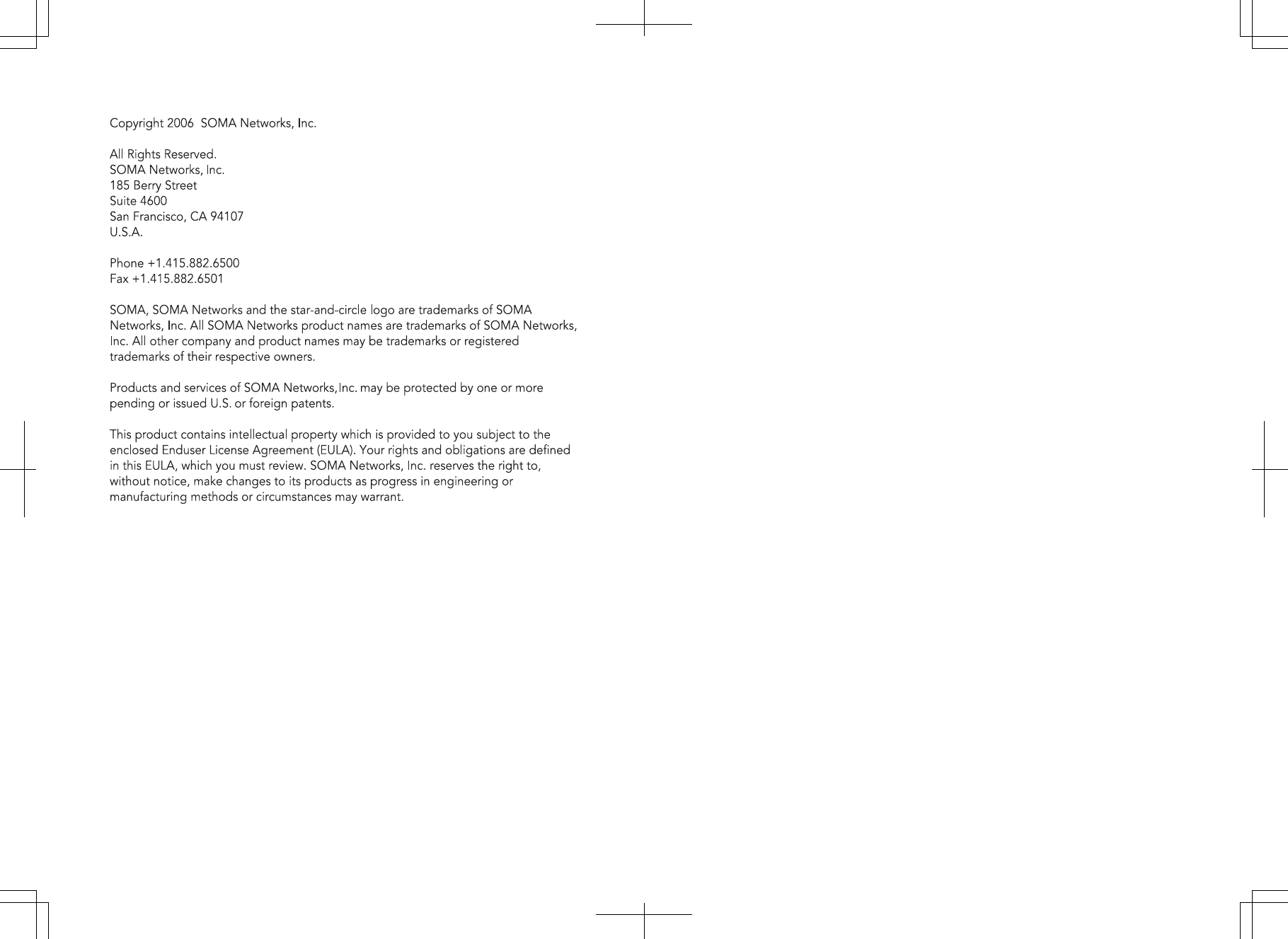

1
SOMAPORT USER GUIDE
Part S1AH6P1P0006-- revision _

2

3
Preface ...........................................................................9
Important Safety Instructions ................................................. 11
Regulatory Notices ................................................................ 15
Introduction .................................................................21
Overview ............................................................................... 22
The Front Panel ..................................................................... 23
The Back Panel ..................................................................... 25
The Internal Antenna .............................................................. 27
Installing the SOMAport .............................................29
Unpacking the SOMAport ...................................................... 30
Choose the Best Location ..................................................... 31
Connecting the Power Supply and Powering on the SOMAport
............................................................................................... 32
Connecting a Computer via Ethernet ..................................... 34
Connecting a Computer via USB (Optional) ........................... 35
Connecting Telephones to SOMAport ................................... 37
Activating Service .................................................................. 42
Connecting Multiple Computers ...............................43
Overview ............................................................................... 44
Using an Ethernet Hub .......................................................... 45
Using an Internet Router ........................................................ 46
CONTENTS

CONTENTS
4
Troubleshooting ..........................................................47
Finding Causes of Computer Problems ................................. 48
Finding Causes of Telephone Problems ................................. 50
The Signal is Weak ................................................................ 52
There is a Fault Condition ...................................................... 54
The SOMAport is Not Receiving Power ................................. 55
There is a Problem with the Ethernet or USB Cabling ............ 56
There is a Problem with the USB Port Settings ...................... 58
The Computer Uses an Old Dial-up Connections ................... 59
Internet Explorer LAN Settings are Incorrect .......................... 61
Ethernet Network Settings are Incorrect ................................ 62
IP Address Needs to be Renewed ......................................... 72
Specifications ..........................................................75
Index .........................................................................77

COPYRIGHT
5
SOMA NETWORKS INC. ENDUSER PRODUCT LICENSE AGREEMENT
THE SOMAPORT™ SUBSCRIBER STATION AND PROVIDED SOFTWARE CONTAIN CERTAIN
COMPUTER PROGRAMS AND OTHER PROPRIETARY MATERIAL OF SOMA NETWORKS, INC. OR
LICENSED TO SOMA NETWORKS, INC., THE USE OF WHICH IS SUBJECT TO THIS AGREEMENT.
BY: (A) SIGNING AN AGREEMENT FOR SERVICE WITH YOUR SERVICE PROVIDER; (B) OPENING
THE SEALED ENVELOPE CONTAINING THE SOMAPORT; OR (C) USING THE SOMAPORT, YOU
ASSENT TO AND ACCEPT THIS ENDUSER PRODUCT LICENSE AGREEMENT. IF YOU DO NOT
AGREE WITH ALL THE TERMS OF THIS AGREEMENT YOU MUST RETURN THIS PRODUCT (WITH
THE ENVELOPE STILL SEALED), ALL MANUALS AND DOCUMENTATION, ANY SOFTWARE PACK-
AGES PROVIDED WITH THE SOMAPORT AND PROOF OF PAYMENT TO THE PLACE YOU
OBTAINED THEM FOR A FULL REFUND WITHIN THIRTY (30) DAYS OF FIRST ACQUIRING THE
SOMAPORT, OTHERWISE YOU ARE DEEMED TO HAVE ACCEPTED AND AGREED TO THESE
TERMS AND CONDITIONS. UNAUTHORIZED REPRODUCTION, DISTRIBUTION, DECOMPILATION
OR OTHER REVERSE ENGINEERING OF THIS PRODUCT INCLUDING ITS HARDWARE AND/OR
SOFTWARE, OR ANY PORTION OF IT, IS PROHIBITED AND MAY RESULT IN SEVERE CIVIL AND
CRIMINAL PENALTIES, AND WILL BE PROSECUTED TO THE MAXIMUM EXTENT POSSIBLE
UNDER THE LAW.
1. GRANT OF LICENSE: Subject to the terms of this Enduser Product License Agreement (the
"Agreement"), SOMA Networks, Inc. ("SOMA") grants you (the "Licensee") a non-sub-licensable,
non-exclusive right ("License") to use the Product. "Product" means, collectively, the Software and
the provided hardware, and specifically the SOMAport™ subscriber station and its accessories, if
any, together with documentation provided to you by SOMA or your service provider. "Software"
means, collectively, the version of the SOMA software program in object code format and all
updates to that program distributed to you by SOMA, directly or indirectly, by any means and
includes any firmware provided to you with the Product. You have no right, unless otherwise explic-
itly permitted, to receive any source code or design documentation relating to the Product. SOMA
retains ownership of all Software copies. The Software and this License is only provided to you to
be used in conjunction with the SOMAport provided to you by SOMA or your service provider when
you subscribed to services that utilize the SOMA wireless air interface technology and is not
licensed to you to be used for any other purpose.
2. RESTRICTIONS: Except as reasonably required to use the Product strictly in accordance with
the License and this Agreement, you may not copy any Software. Licensee shall not (and shall not
allow any third party to): (I) decompile, disassemble, or otherwise reverse engineer or attempt to
reconstruct or discover any source code or underlying ideas or algorithms or file formats or pro-
gramming or interoperability interfaces of the Product by any means whatsoever; (II) remove any
Product identification, copyright or other notices; (III) modify, incorporate into or with other software
or create a derivative work of any part of the Software or Product; or (IV) modify or otherwise alter
the operation of the Product. Various components, functions, routines and/or portions of the Prod-
uct may be protected by Intellectual Property Rights ("IPR") including, but not limited to, designs,
copyrights, trade secrets and one or more patents or pending patent applications. Licensee is
licensed under such IPR, if any, only to the extent that such a license is required by the licensee to
operate the Product in the manner intended by SOMA. No other rights are granted under such IPR

COPYRIGHT
6
and no right to repair or replace the Product is intended or provided and specifically, no right of
reconstruction, substitution or repair is provided.
3. TERMINATION: This License is effective until terminated. This License will terminate automatically
if you fail to cure any material breach, as determined at the sole discretion of SOMA, of this Agree-
ment within thirty (30) days after such breach first occurs (or immediately in the case of a breach of
§2). Upon termination, you shall immediately cease all use of the Product and return all of the Prod-
uct including Software, hardware, manuals, documentation of any kind accompanying Product to
the place where you first obtained such Product or such other location as may be designated from
time to time. Except for this License and except as otherwise expressly provided herein, the terms
of the Agreement shall survive termination.
4. WARRANTY DISCLAIMER: THE SOFTWARE IS PROVIDED "AS IS" WITHOUT WARRANTY OF
ANY KIND INCLUDING, WITHOUT LIMITATION, ANY WARRANTY OF MERCHANTABILITY OR FIT-
NESS FOR A PARTICULAR PURPOSE OR NONINFRINGEMENT. FURTHER, SOMA DOES NOT
WARRANT, GUARANTEE OR MAKE ANY REPRESENTATIONS REGARDING THE USE, OR THE
RESULTS OF THE USE, OF THE PRODUCT OR WRITTEN MATERIALS IN TERMS OF CORRECT-
NESS, ACCURACY, RELIABILITY, OR OTHERWISE. YOUR SERVICE PROVIDER MAY PROVIDE
FURTHER WARRANTY COVERAGE FOR YOU.
5. LIMITATION ON REMEDIES AND DAMAGES: SOMA SHALL NOT BE RESPONSIBLE OR LIABLE
UNDER ANY CIRCUMSTANCE WITH RESPECT TO ANY SUBJECT MATTER OF THIS ENDUSER
PRODUCT LICENSE AGREEMENT UNDER ANY CONTRACT, NEGLIGENCE, STRICT LIABILITY OR
OTHER THEORY: (A) FOR LOSS OR INACCURACY OF RECORDS OR DATA OR (EXCEPT FOR
RETURN OF AMOUNTS PAID TO SOMA THEREFOR) COST OF PROCUREMENT OF SUBSTITUTE
GOODS, SERVICES OR TECHNOLOGY, (B) FOR ANY SPECIAL, INDIRECT, INCIDENTAL OR CON-
SEQUENTIAL DAMAGES INCLUDING, BUT NOT LIMITED TO, LOSS OF PROFITS, LOSS OF SAV-
INGS, (C) THIRD-PARTY CLAIMS AGAINST YOU FOR DAMAGES, OR (D) FOR ANY MATTER
BEYOND THE REASONABLE CONTROL OF SOMA EVEN IF SOMA AND / OR ITS SUPPLIERS IS/
ARE INFORMED OF THEIR RESPONSIBILITY. SOME JURISDICTIONS DO NOT ALLOW FOR THE
EXCLUSION OR LIMITATION OF INCIDENTAL OR CONSEQUENTIAL DAMAGES, SO THE ABOVE
LIMITATION OR EXCLUSION MAY NOT APPLY TO YOU.
6. UPDATES TO SOFTWARE and TRANSMISSION OF PERSONAL DATA: You consent to receive
and employ updates to Software, without requiring further notice to you, that may occur from time
to time, as may be necessary, as determined at the sole discretion of SOMA and/or your service
provider, for the use of Product by you and for the efficient utilization of services as may be pur-
chased or subscribed to by you from your service provider. You also agree to the application of the
terms of this Agreement to any and all such updates. You accept and acknowledge that Software
shall be able to transmit such data as is authorized by your service provider in order to allow for the
utilization of services subscribed or purchased by you in order to allow for the billing of such ser-
vices or as may be necessary by law.
7. MISCELLANEOUS: This Agreement and the License provided by this Agreement are not assign-
able or transferable by you without the prior written consent of SOMA. Any attempt by you to do so

COPYRIGHT
7
shall be void and void this License. Any notice, report, approval or consent required or permitted
hereunder shall be in writing. If any provision of this Agreement shall be adjudged by any court of
competent jurisdiction to be unenforceable or invalid, that provision shall be limited or eliminated to
the minimum extent necessary so this Agreement shall otherwise remain in full force and effect and
enforceable. This Agreement shall be construed pursuant to the laws of the United States of Amer-
ica and the State of California and without regard to conflicts of laws principles thereof. If success-
ful in any action to enforce this Agreement, SOMA shall be entitled to recover costs and expenses
including, without limitation, attorney's fees. The parties agree that a material breach of this Agree-
ment would cause irreparable injury to SOMA, or its suppliers, for which monetary damages would
be an adequate equitable relief and SOMA shall be entitled to any other remedies it may have avail-
able hereunder or at law. Both parties agree that this Agreement is the complete and exclusive
statement of mutual understanding of the parties and supersedes and cancels all previous written
and oral agreements and communications relating to the subject matter of this Agreement. BOTH
YOU AND SOMA AGREE AND ACKNOWLEDGE THAT SOMA RESERVES THE RIGHT TO AMEND
THE TERMS AND CONDITIONS OF THIS AGREEMENT WITHOUT FURTHER NOTICE TO YOU
OTHER THAN PROVIDING TO YOU THE AMENDED TERMS AND CONDITIONS OF THIS AGREE-
MENT. IF YOU DO NOT ACCEPT THE AMENDED TERMS AND CONDITIONS AS PROVIDED TO
YOU BY SOMA, THIS LICENSE SHALL TERMINATE IMMEDIATELY. ALL USE OF THE SOFTWARE
AND ANY SERVICES SUPPORTED BY THE PRODUCT AND SOFTWARE MAY CEASE OR BE
CAUSED TO BE CEASED WITHOUT ANY LIABILITY TO YOU BY SOMA AND YOU SHALL RETURN
ALL PRODUCT HARDWARE, MANUALS, DOCUMENTATION OF ANY KIND ACCOMPANYING
SOFTWARE TO THE PLACE WHERE YOU FIRST OBTAINED SUCH HARDWARE, MANUALS, DOC-
UMENTATION AND SOFTWARE

COPYRIGHT
8

9
Conventions
This section outlines the conventions used in this guide.
Measurement Conventions
Measurements in this guide are expressed according to the Systéme
International d’Unites standards for metric units and abbreviation.
Equivalent Imperial measurements (used in the United States) are
provided in parentheses, except when Imperial is the international
standard.
Bits and bytes are not abbreviated, though their prefixes are; for
example, "kbits" for kilobits, "Gbytes" for gigabytes.
Trademark Identification
The SOMAport™ subscriber device, a trademark of SOMA Networks
Inc., is referred to without notation in the rest of this document.
PREFACE
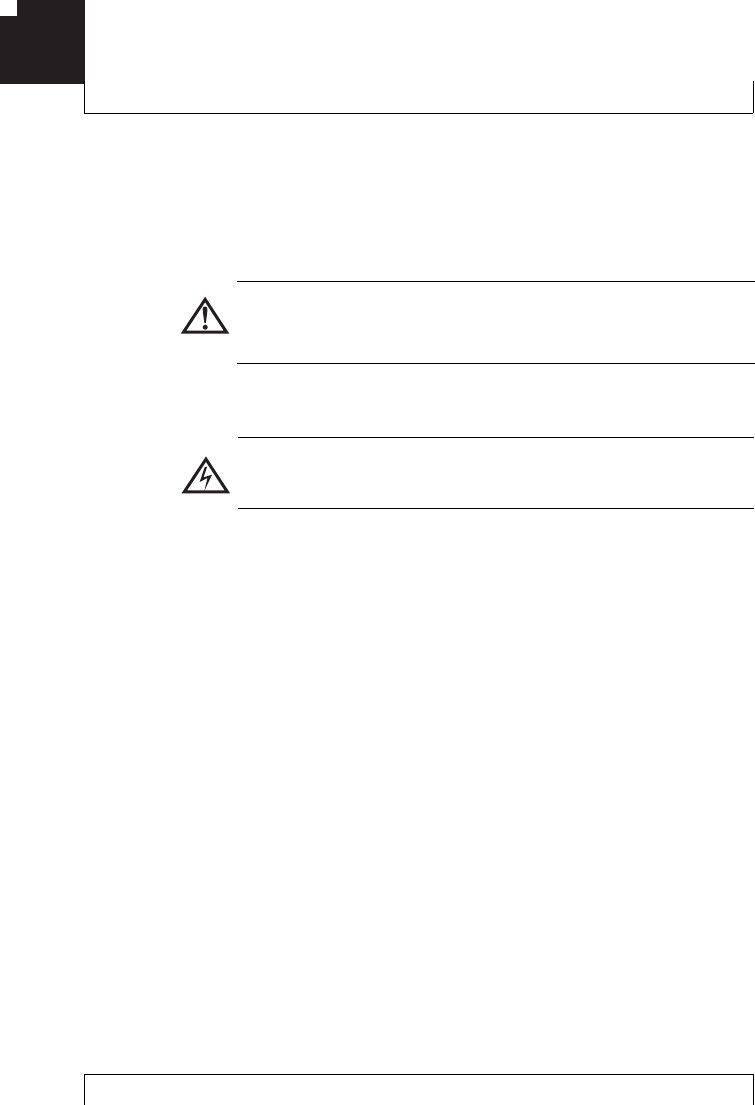
PREFACE
10
Alerts Used in This Guide
WARNING: Where you see this symbol and the WARNING
heading, strictly follow the instructions to avoid personal
injury or damage to the product.
WARNING: Where you see this symbol and the WARNING
heading, strictly follow the instructions to avoid electric
shock.
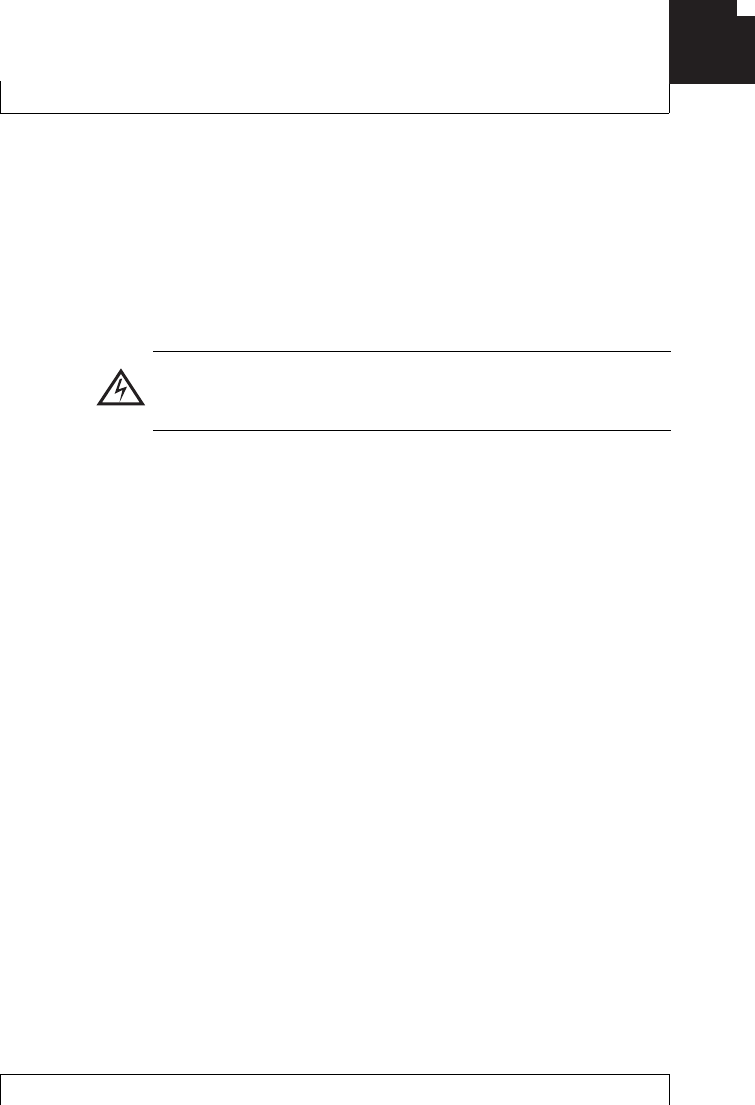
PREFACE
11
IMPORTANT SAFETY INSTRUCTIONS
For your safety and protection, read this entire guide before you
attempt to install the SOMAport. In particular, read this safety section
carefully. Keep this safety information where you can refer to it if
necessary.
Installation
Read Instructions
Read and follow all of the safety and operating instructions before
operating the SOMAport.
Retain Instructions
Retain the safety and operating instructions for future reference.
Follow Instructions
Follow all operating instructions.
Heed Warnings
Adhere to all warnings on the SOMAport and in the operating
instructions.
Ventilation
Slots and openings in the SOMAport housing provide ventilation,
ensure its reliable operation, and protect it from overheating.
WARNING: One milliampere of current flowing through your
body can kill you. Voltage as low as 15 volts can kill under the
right conditions. Treat energized equipment with respect.
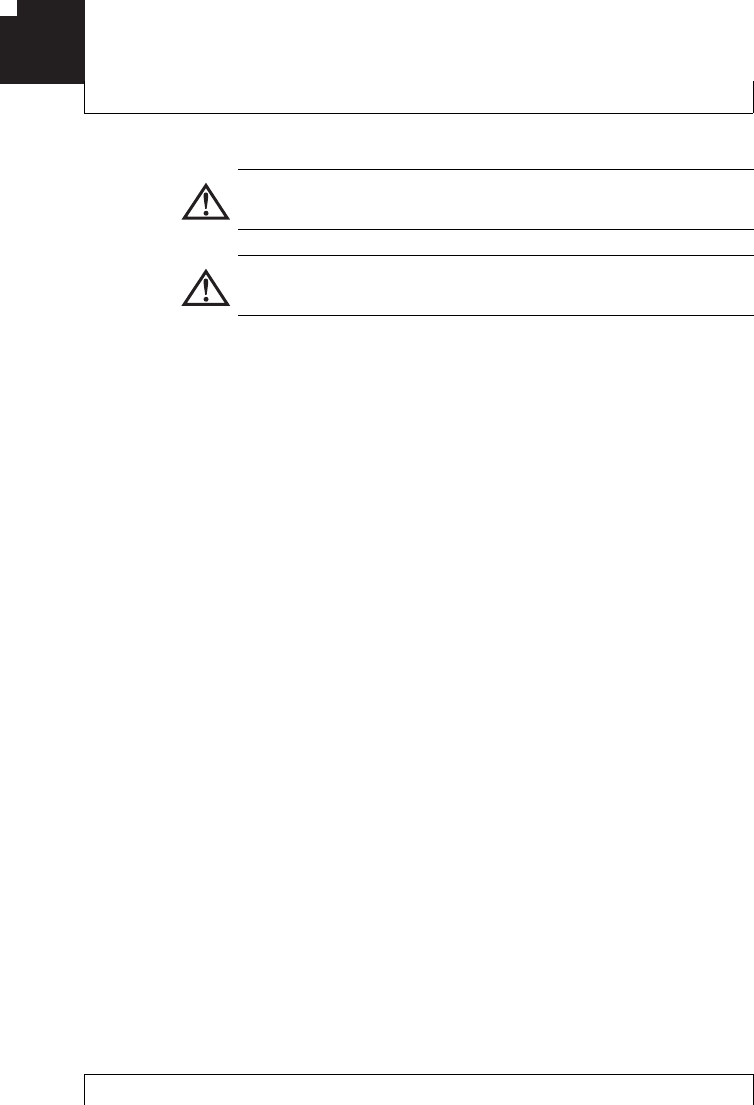
PREFACE
12
Do not place the SOMAport in a closed-off location such as a
bookcase or rack unless there is proper ventilation.
Setup Orientation
Keep the SOMAport in an upright, vertical position. Placing the
SOMAport on its side or in other positions may interrupt its cooling
and cause the unit to overheat.
Operating Environment
Avoid placing the SOMAport in an environment of high temperature
and high humidity. In case of condensation found on the SOMAport,
immediately unplug the power cord from the power outlet.
Once the condensation disappears, re-insert the power plug into a
power outlet.
Power Sources
Use only the type of power source indicated on the label. If you are
not sure of the type of power supplied to your home, consult your
product dealer or local power company.
Power Supply Cord
The power supply cord is the disconnect device. Ensure that the
socket outlet is installed near the equipment and can be easily
accessed.
Telephone Line Cord
To reduce the risk of fire, use only No. 26 AWG or larger telephone
line cord.
WARNING: Do not block or cover these openings. The
openings prevent the SOMAport from overheating.
WARNING: The air from the top openings (holes) may be hot.
Do not touch the heated air as it may cause burning.

PREFACE
13
Grounding or Polarization
The plug for the power cord on the SOMAport fits into the power
outlet only one way. If you are unable to insert the plug fully into the
outlet, contact your electrician to replace your outlet. To prevent
electric shock, do not use this plug with an extension cord or outlet
unless you can fully insert the blades without blade exposure. Do not
defeat the safety purpose of this plug.
Power Cord Protection
Route power-supply cords so that they are not likely to be walked on
or pinched by items placed upon or against them. Watch for wear in
the cord at the plug and socket.
Accessories
To avoid personal injury or damage to the SOMAport, do not place it
on an unstable cart, stand, tripod, bracket, or table.
Attachments
Do not use attachments with the SOMAport that have not been
recommended in this guide as they may cause hazards.
Water and Moisture
Do not use the SOMAport near water or moisture.

PREFACE
14
Maintenance and Servicing
Cleaning
Unplug the SOMAport from the wall outlet before cleaning. Use a dry
cloth for cleaning. Do not use liquid or aerosol cleaners.
Servicing
Do not attempt to service the SOMAport yourself. Opening or
removing covers may expose you to dangerous voltage or other
hazards and may void the warranty. There are no user-serviceable
parts inside. Refer all servicing to qualified service personnel.
Conditions Requiring Service
Unplug the SOMAport from the wall outlet and refer servicing to
qualified service personnel under the following conditions:
The power supply or cord is damaged.
Liquid has been spilled on the SOMAport or it has been
exposed to water.
An object has fallen into the SOMAport.
The SOMAport does not function normally even though you
have adhered to the operating instructions and have made
adjustments to only those controls covered by the operating
instructions.
The SOMAport has been dropped and a change in
performance has occurred.
The SOMAport exhibits a distinct change in performance.

PREFACE
15
REGULATORY NOTICES
FCC Part 15 Notice (Applicable to Use Within the U.S.A)
This equipment complies with part 15 of the FCC Rules. Operation is
subject to the following two conditions: (1) This device may not cause
harmful interference, and (2) This device must accept any interference
received, including interference that may cause undesired operation.
This equipment has been tested and found to comply with the limits for
a Class B digital device, pursuant to Part 15 of the FCC Rules. These
limits are designed to provide reasonable protection against harmful
interference in a residential installation. This equipment generates,
uses, and can radiate radio frequency energy and, if not installed and
used in accordance with the instructions, may cause harmful
interference to radio communications. However, there is no guarantee
that interference will not occur in a particular installation. If this
equipment does cause harmful interference to radio or television
reception, which can be determined by turning the equipment off and
on, you can try to correct the interference by:
Relocating the SOMAport
Increasing the distance between the SOMAport and the
device experiencing the interference
Connecting the equipment to an outlet on a circuit different
from that to which the SOMAport is connected
ATTENTION: Changes or modifications not expressly approved
by SOMA Networks for compliance could void the user’s authority
to operate the equipment.

PREFACE
16
FCC Radio-Frequency Exposure Notice
This equipment should be used in such a manner that the potential for
human contact during normal operation is minimized. To avoid the
possibility of exceeding the FCC radio frequency exposure limits, this
equipment has to be installed and operated while maintaining a
minimum body to antenna distance of 20 cm.
Industry Canada Notice (Applicable to Use Within Canada)
This equipment complies with the limits for a Class B digital device and
conforms to Industry Canada standard ICES-003.
Avis de Conformité à la Réglementation
d’Industrie Canada
Cet appareil numérique de la classe B est conform à la norme
ICES-003 du Canada.
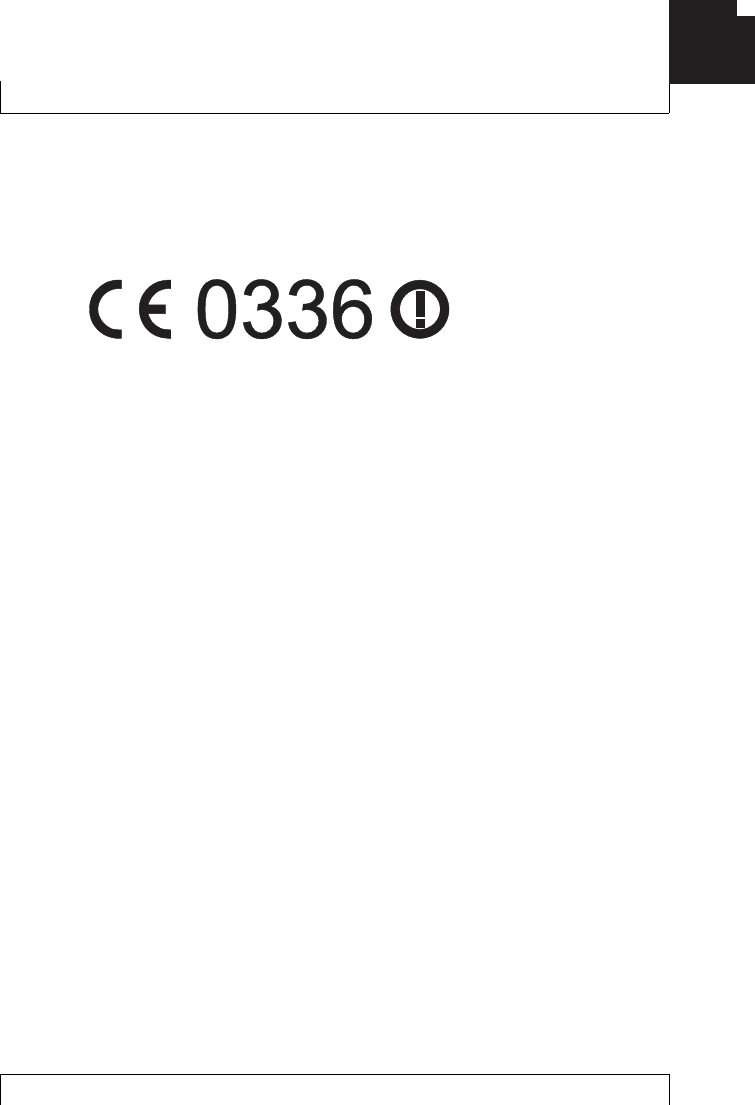
PREFACE
17
Notice for European Community
Marking by the symbol
The SOMAport complies with the R&TTE Directive 1999/5/EC. Such
marking is indicative that this equipment meets or exceeds the
following technical standards:
Radio
ETSI EN 301 753 - Fixed Radio Systems; Multipoint
equipment and antennas; Generic harmonized standard
for multipoint digital fixed radio systems and antennas
covering the essential requirements under article 3.2 of
the Directive 1999/5/EC
ETSI EN 301 489-1 - Electromagnetic compatibility and
Radio spectrum Matters (ERM); ElectroMagnetic
Compatibility (EMC) standard for radio equipment and
services; Part 1: Common technical requirements
ETSI EN 301 489-4 - Electromagnetic compatibility and
Radio spectrum Matters (ERM); ElectroMagnetic
Compatibility (EMC) standard for radio equipment and
services; Part 4: Specific conditions for fixed radio links
and ancillary equipment and services
EMC
EN 300 386 - Electromagnetic compatibility and Radio
spectrum Matters (ERM); Telecommunication network
equipment; ElectroMagnetic Compatibility (EMC)
requirements
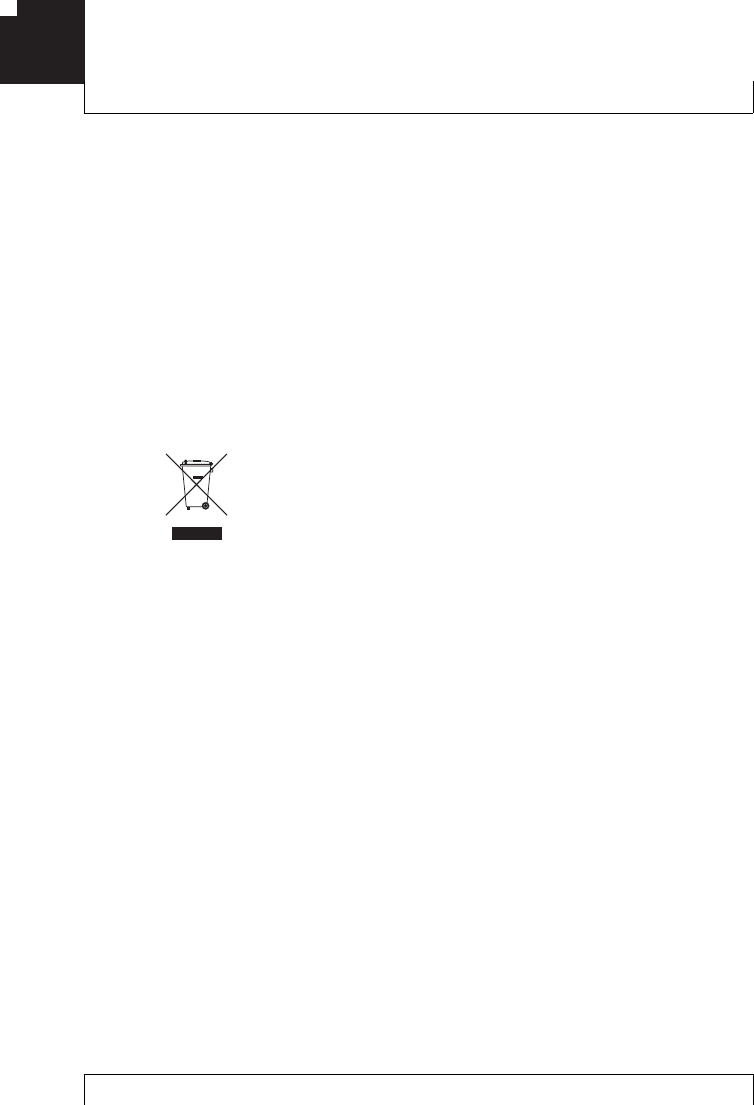
PREFACE
18
ETSI EN 55022:1998+A1:2000+A2:2003 (Class B) -
Information technology equipment. Radio disturbance
characteristics. Limits and methods of measurement
Safety
ETSI EN 60950-1:2001 - Information technology
equipment-Safety-Part1: General requirements
WEEE (Directive 2002/96/EC) Compliance
Your product is designed and manufactured with high quality materials
and components which can be recycled and reused.
This symbol means that electrical and electronic equipment, at their
end-of-life, should be disposed of separately from your household
waste. Please dispose of this equipment at your local community waste
collection/recycling centre. In the European Union there are separate
collection systems for used electrical and electronic products.
Please help us to conserve the environment we live in!

PREFACE
19
EU Declaration of Conformity
Safety Compliance Notice
This equipment has been tested and certified according to the
following safety standards:
MET (Complies with UL 60950-1, CSA C22.2 No. 60950-1)
IEC 60950-1
EN 60950-1
DECLARATION OF CONFORMITY
SOMA Networks, Inc.,
185 Berry Street, Suite 4600
San Francisco, CA 94107 U.S.A.
(415) 882-6500
declares, that the product SOMAport complies with
the requirements of the R&TTE Directive 1999/5/EC
and carries the CE marking accordingly.

PREFACE
20

21
This chapter provides an introduction to the SOMAport subscriber terminal.
Please read this chapter to familiarize yourself with the features and operation of
the device.
Contents
Overview ............................................................................................. 22
The Front Panel ................................................................................... 23
The Back Panel ................................................................................... 25
The Internal Antenna ........................................................................... 27
INTRODUCTION

INTRODUCTION
22
OVERVIEW
The SOMAport™ subscriber terminal provides high-speed Internet
access and telephone service. The SOMAport works like a cell phone,
in that it communicates with your service provider’s network over the
air and does not require a special wire connection.
Installation is easy. You simply plug-in the SOMAport and connect it to
your computer using the provided Ethernet or USB (optional) cable.
The SOMAport will automatically connect to your service provider and
you can setup your account using a Web browser.
If you are using your SOMAport to provide telephone service, you can
connect ordinary telephones to it.
Internet Access
The SOMAport provides a high-speed, "always on" Internet
connection, which means you can be connected to the Internet and still
use your telephone. The SOMAport is designed to be left on – you do
not need to turn it off when not in use.
Telephone Service
The telephone service provided by the SOMAport is independent and
separate from your phone service. Wireless services may differ from
your traditional wired services. Consult your wireless service provider
for details.
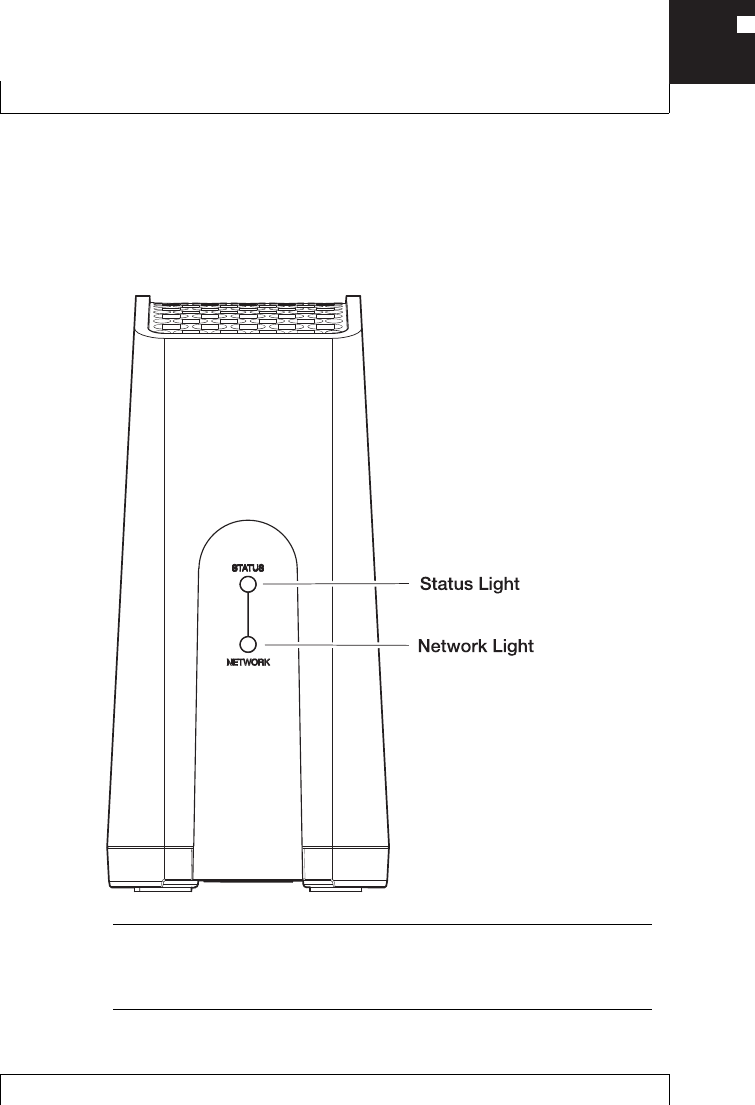
INTRODUCTION
23
THE FRONT PANEL
There are two lights on the front panel that indicate the state of the
SOMAport: status and network.
NOTE: DO NOT unplug the SOMAport when the status light is flashing
amber. The status light flashes amber during sensitive firmware upgrades
only. Disconnecting or powering off the SOMAport during a firmware
upgrade may damage the unit and render it nonfunctional.

INTRODUCTION
24
Status Light
The status light indicates whether or not the SOMAport is powered on
and operating normally.
Network Light
The network light indicates if the SOMAport has located a base station.
State Description
Off The SOMAport is not receiving power.
Amber The SOMAport is booting and running its internal diagnostics.
Flashing Amber The SOMAport is upgrading its firmware. DO NOT unplug the
SOMAport when this light is flashing. Disconnecting or
powering off the SOMAport during a firmware upgrade may
damage the unit and render it nonfunctional.
Green The SOMAport is powered and operating normally.
Red An error occurred. The SOMAport is not currently functional.
See page 54 “There is a fault condition” in the section of
“Troubleshooting”.
Status Description
Off The SOMAport is not receiving power.
Amber The SOMAport is attempting to locate a base station.
Flashing Amber The SOMAport cannot locate a base station.
Flashing Green The SOMAport has located a base station and is attempting
to establish a connection.
Green The SOMAport has located a base station and has
established a connection.
Red An error occurred. The SOMAport is not currently functional.
See page 54 “There is a fault condition” in the section of
“Troubleshooting”.
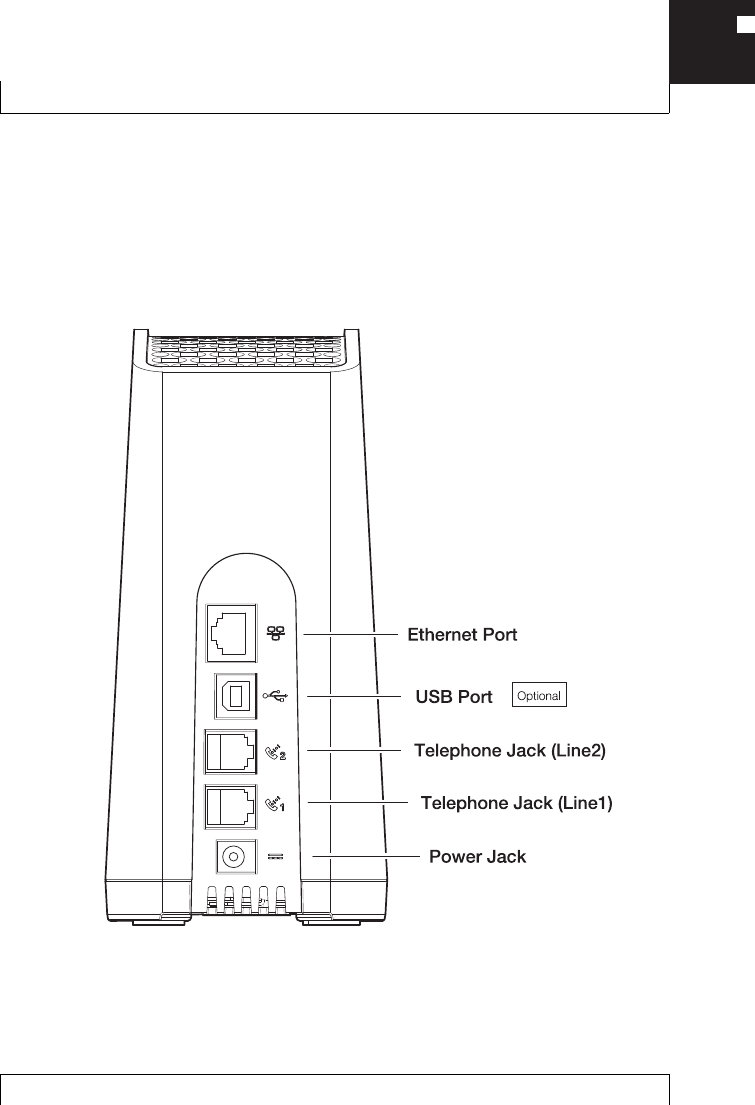
INTRODUCTION
25
THE BACK PANEL
The jacks and ports for connecting other devices to the SOMAport are
on the back panel, as shown below:
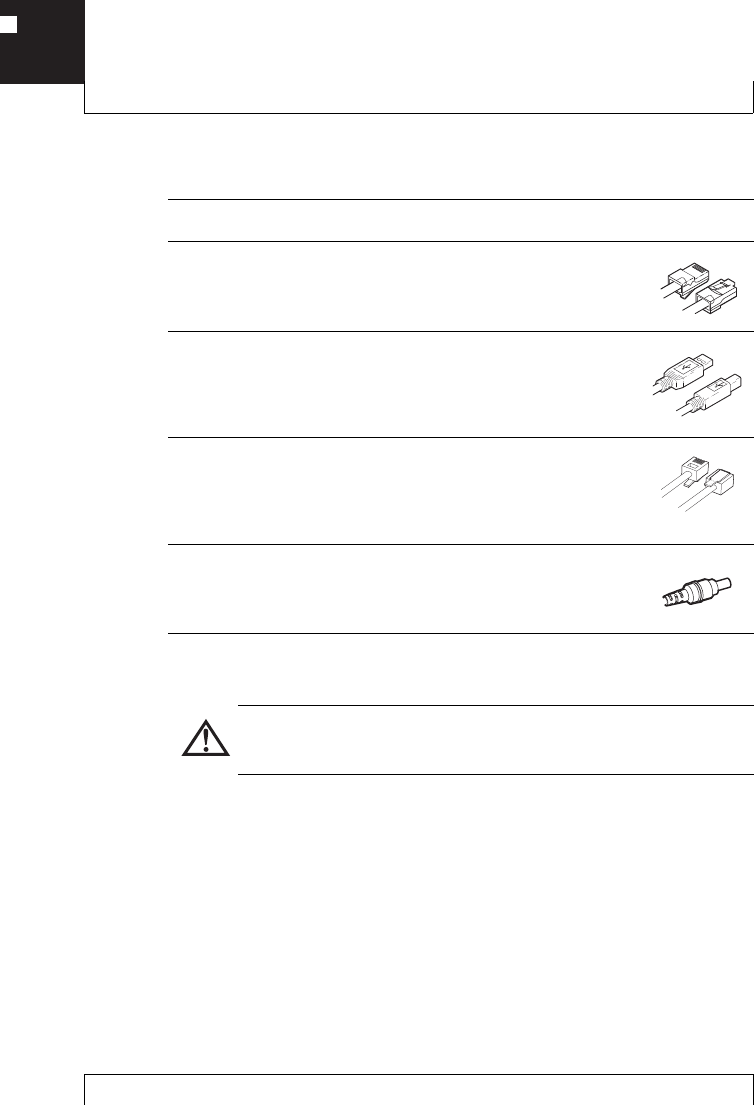
INTRODUCTION
26
Part Description
Ethernet port Use this port with the supplied Ethernet
cable to connect the SOMAport to a
computer or hub.
USB port
(optional) Use this port with the USB cable to
connect the SOMAport to a computer.
This type of connection is intended for
use with computers that do not have an
Ethernet port.
Telephone jacks Use these jacks to connect telephones
to the SOMAport. The SOMAport can
provide up to two independent telephone
lines, depending on your service
provider.
Power jack Use this jack to connect the power
supply.
WARNING: To reduce the risk of fire, use only No. 26 AWG
or larger telephone line cord to connect to the telephone
jacks on the SOMAport.
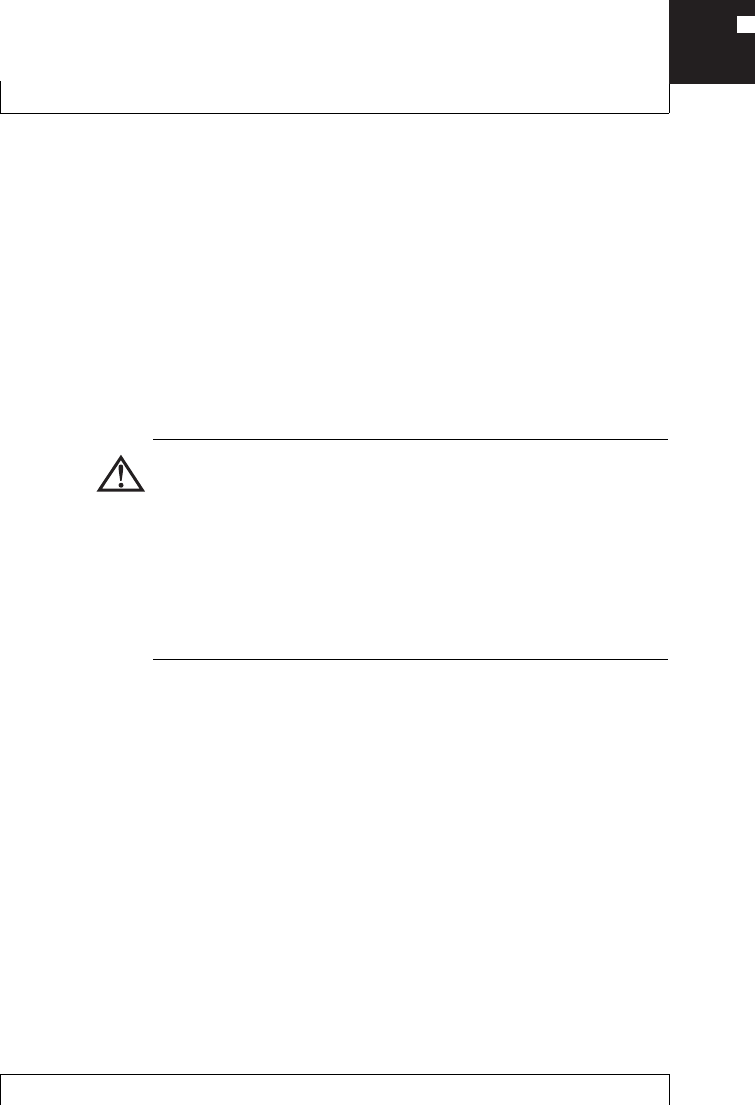
INTRODUCTION
27
THE INTERNAL ANTENNA
The SOMAport communicates with a cellular tower operated by your
wireless service provider. The SOMAport contains an antenna that
automatically steers itself toward the best signal when you plug in the
SOMAport. It also periodically checks to see if the current antenna
direction is optimal and adjusts automatically if required. So, if you
move the SOMAport without unplugging it, and the antenna direction is
no longer optional, the SOMAport automatically steers the antenna to
improve performance.
WARNING: While this device is in operation, a separation
distance of at least 20 centimeters (8 inches) must be
maintained between the radiating antenna and any person
exposed to the transmitter in order to meet the FCC RF
exposure guidelines. No change to the antenna or device is
permitted. Doing so may result in the installed system
exceeding RF exposure requirements. This device must not
be co-located or operating in conjunction with any other
antenna or radio transmitter. Installers and end users must
follow the installation instructions provided in this guide.

INTRODUCTION
28

29
This chapter describes how to install the SOMAport and activate service.
After following the procedures described in this chapter, your SOMAport should
be fully functional.
Contents
Unpacking the SOMAport ..................................................................... 30
Choosing the Best Location .................................................................. 31
Connecting the Power Supply and Powering on the SOMAport .......... 32
Connecting a Computer via Ethernet ................................................... 34
Connecting a Computer via USB (Optional) ......................................... 35
Connecting Telephones to SOMAport ................................................. 37
Activating Service ................................................................................ 42
INSTALLING THE SOMAPORT
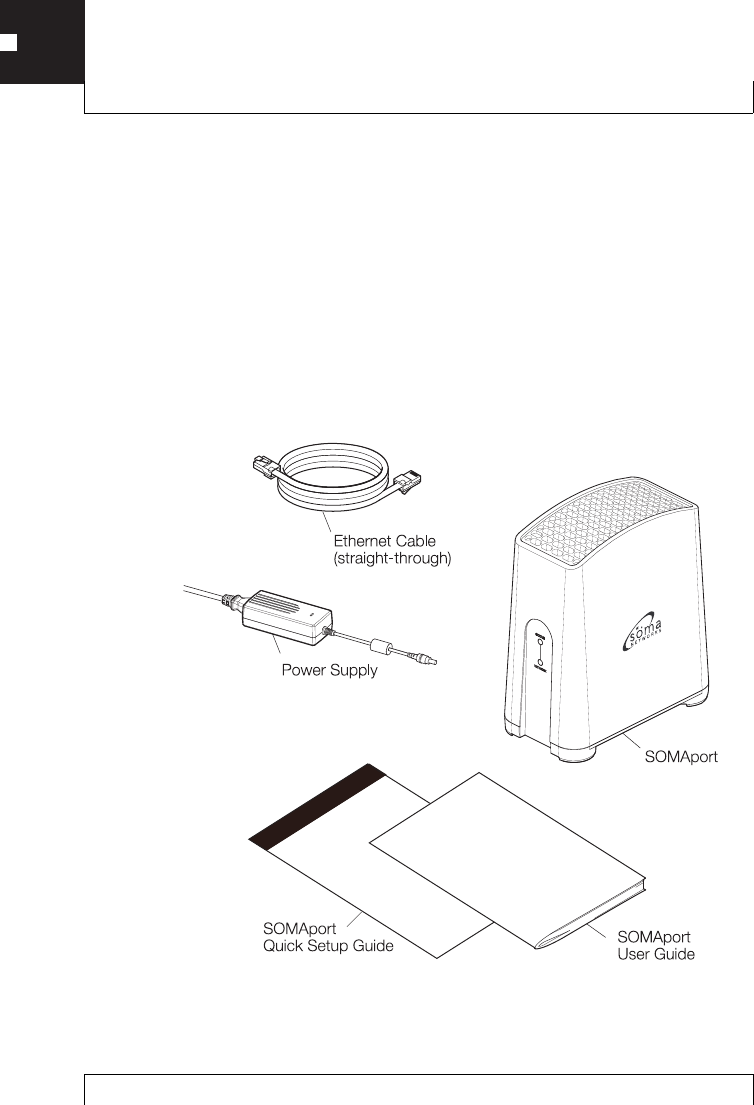
INSTALLING THE SOMAPORT
30
UNPACKING THE SOMAPORT
Unpack the SOMAport and make sure you have all the pieces shown
below. Find the SOMAport serial number on the bottom of the unit and
write it down. You may need this number if you call for technical
support.
SOMAport Serial Number:
___________________________________________

INSTALLING THE SOMAPORT
31
CHOOSE THE BEST LOCATION
Although the SOMAport’s internal antenna is self-steering, you can
optimize signal reception by following these recommendations when
choosing a location:
Allow at least 46 centimeters (18 inches) of space around the
SOMAport.
If your home or office has multiple floors, place the SOMAport
on one of the upper floors, if possible. Avoid putting it in the
basement.
Place the SOMAport higher up in a room. For example,
putting it on a desk or shelf will give you a stronger signal than
if you place it on the floor.
Place the SOMAport near a window.
Avoid placing the SOMAport close to certain electronic
devices, such as microwave ovens and computer monitors,
as they can cause interference.
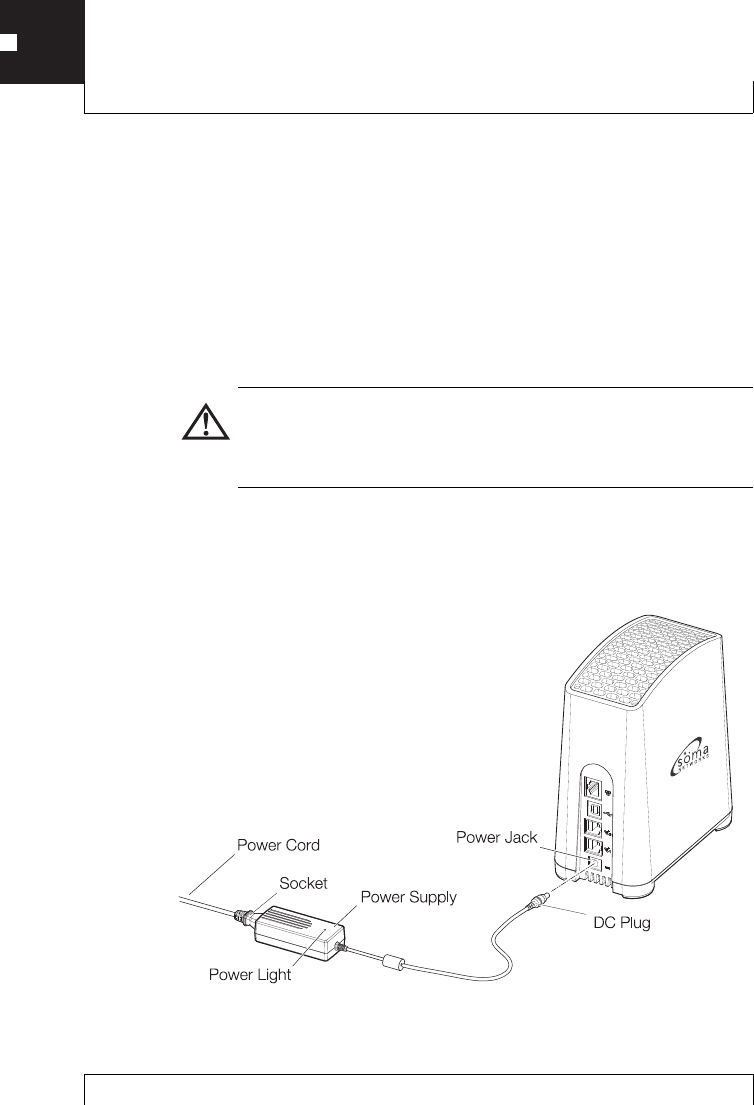
INSTALLING THE SOMAPORT
32
CONNECTING THE POWER SUPPLY AND
POWERING ON THE SOMAPORT
The SOMAport does not have a power switch. You turn on the
SOMAport by plugging it into a power outlet, and turn it off by
unplugging it. When you plug in the SOMAport, it starts, connects to
your service provider’s network, and establishes a connection.
To connect the power supply and power on the SOMAport
1Insert the DC plug on the power supply cord into the power jack on the back of
the SOMAPort.
WARNING: Use only the power supply and power cord that
come with the SOMAport. Using another power supply may
damage your equipment and poses the risk of shock or
electrocution.
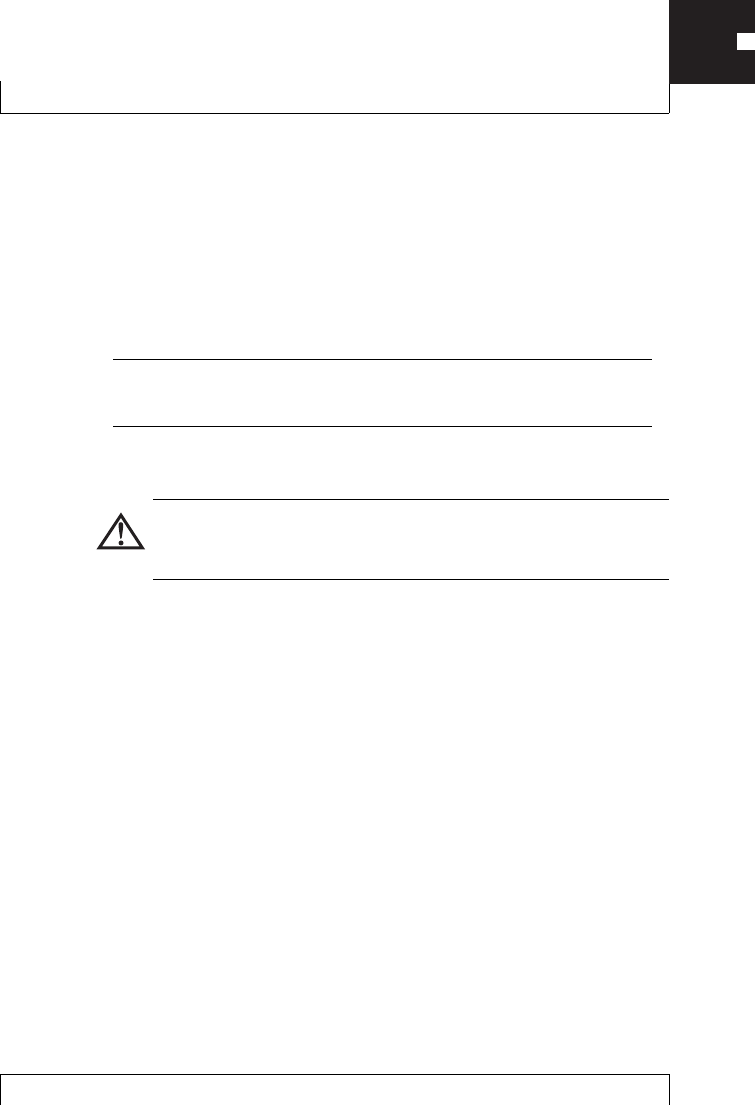
INSTALLING THE SOMAPORT
33
2Insert the socket end of the power cord into the power supply’s receptacle.
3Insert the plug end of the power cord into a three-prong grounded power outlet.
There is no power button. The light on the power supply turns on when it is
receiving power.
4The SOMAport takes up to five minutes to start, acquire a radio signal, and
connect to the network. Wait for the network light on the front panel to turn green
before you attempt to use the SOMAport.
NOTE: If you ever need to disconnect the SOMAport, unplug the power
cord from the wall power outlet first and then unplug the connector from
the back of the SOMAport.
WARNING: The power supply cord is the disconnect device.
Ensure that the socket outlet is installed near the equipment
and can be easily accessed.
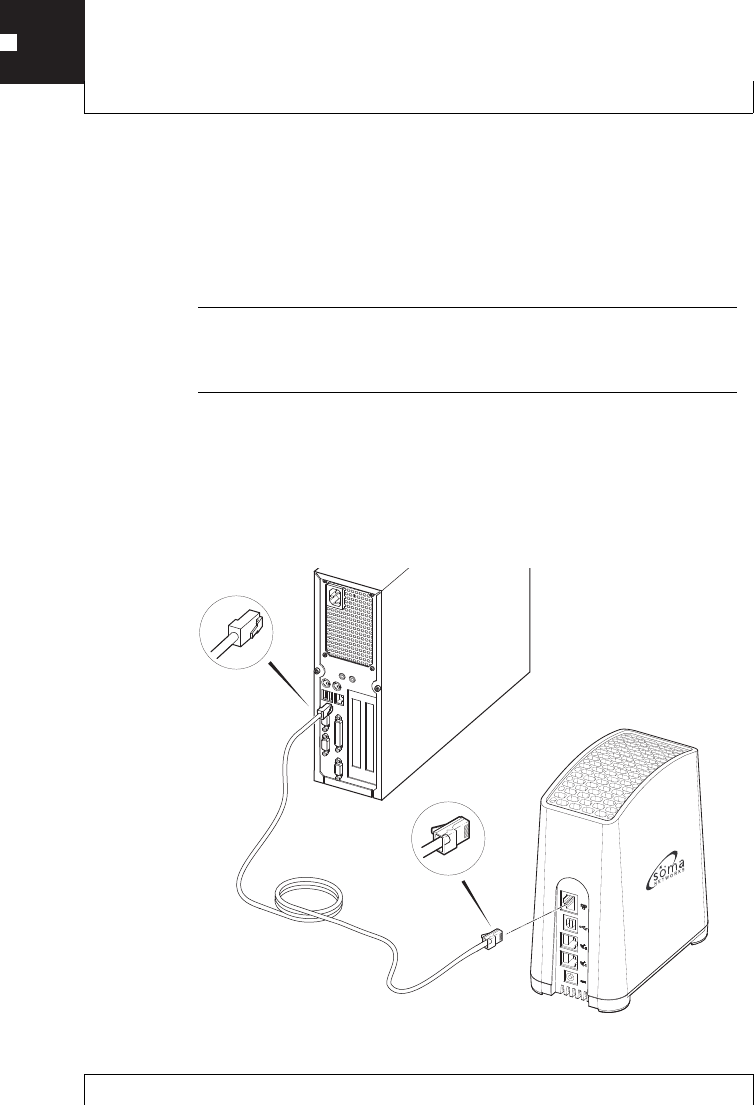
INSTALLING THE SOMAPORT
34
CONNECTING A COMPUTER VIA ETHERNET
If your computer has an Ethernet port, use the supplied Ethernet cable
to connect your computer to the SOMAport.
NOTE: If your computer does not have an Ethernet port, you can use a
USB cable, if supported by your SOMAport. Otherwise, you will need to
purchase an Ethernet card or an Ethernet-to-USB adapter. Contact your
service provider for information about supported hardware.
To connect a computer via Ethernet
1Insert one end of the supplied Ethernet cable into the Ethernet port on the back of
the SOMAport.
2Insert the other end of the cable into the Ethernet port on your computer.
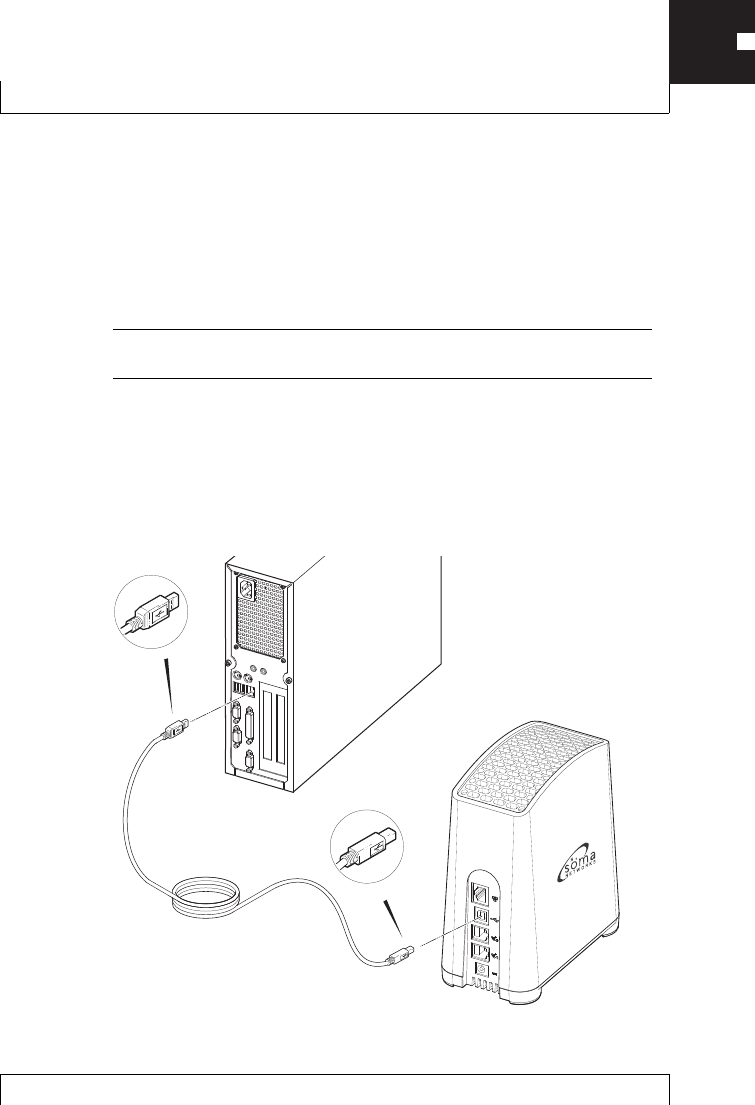
INSTALLING THE SOMAPORT
35
CONNECTING A COMPUTER VIA USB (OPTIONAL)
If your computer does not have an Ethernet port and it is running
Windows 98SE, ME, 2000, or XP, you can use the supplied USB cable
to connect your computer to the SOMAport.
NOTE: Ethernet is the preferred type of connection. The USB connection
should only be used in computers that do not support Ethernet.
To connect a computer via USB
1Insert the SOMAport USB Drivers CD into the CD-ROM drive on the computer.
2Plug the square connector on the USB cable into the USB port on the back of the
SOMAport.
3Plug the flat connector into the USB port on your computer.

INSTALLING THE SOMAPORT
36
A hardware wizard window opens.
You will see the following message at the beginning of the installation:
The software you are installing for this hardware:
SOMAport USB (SOMAport.SYS) has not passed Windows Logo
testing to verify its compatibility with Windows.
Click Continue Anyway. The drivers have passed stringent
internal testing by SOMA Networks, Inc.
4Follow the on-screen instructions in the wizard, making sure you select the values
indicated in the following table for your version of Windows.
5Close the wizard windows and remove the CD from the drive. If prompted to do
so, reboot your computer.
Version Selections
Windows 98 When prompted for the type of search, select Search
for the best driver for your device.
When prompted for a location, select CD-ROM drive.
Insert the Windows 98 Second Edition CD if
prompted.
Windows 2000 When prompted for the type of search, select Search
for a suitable driver for your device.
When prompted for a location, select CD-ROM
drives.
Windows ME When prompted for the type of search, select
Specify a location.
When prompted for a location, select Removable
Media.
Windows XP When prompted for the type of search, select Install
the software automatically.

INSTALLING THE SOMAPORT
37
CONNECTING TELEPHONES TO SOMAPORT
In order to use a telephone with your SOMAport, you will need to
subscribe to your service provider’s telephone service during service
activation.
If telephone service is not available in your area or if you do not want to
use telephones with your SOMAport, skip to "Activating Service" on
page 42.
Telephone Jacks
There are two telephone jacks on the back of the SOMAport,
one for line 1 (lower one) and the other for line 2 (upper one).
How you connect telephones to the SOMAport depends on three
things:
The number of lines you subscribe to (one or two)
The number of telephones you connect to the SOMAport
The type of telephones you connect
(one-line or two-line telephones)

INSTALLING THE SOMAPORT
38
Lines Connecting One
Telephone Connecting Two Telephones
One Use the line 1 (lower one) jack.
See "To connect a single
telephone" on page 39.
Insert a duplex adapter into the line 1
(lower one) jack and then connect
both telephones to the adapter. See
"To connect two telephones (when
you have one line)” on page 41.
Two Use the line 1 (lower one) jack.
See "To connect a single
telephone" on page 39.
Connect telephones to both jacks.
See "To connect two telephones
(when you have two lines)" on page
40.
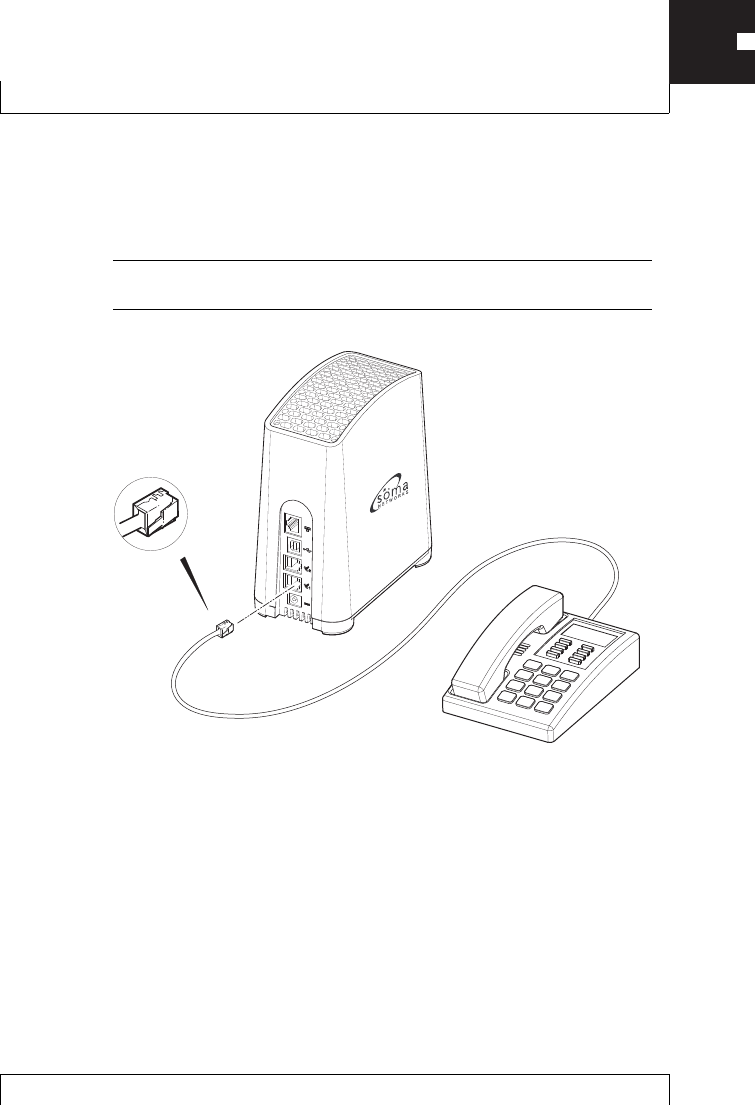
INSTALLING THE SOMAPORT
39
To connect a single telephone to the SOMAport
1Insert the free end of the telephone cable into the line 1 (bottom) jack on the
SOMAport.
NOTE: To connect a two-line telephone, you need to subscribe to two
lines.
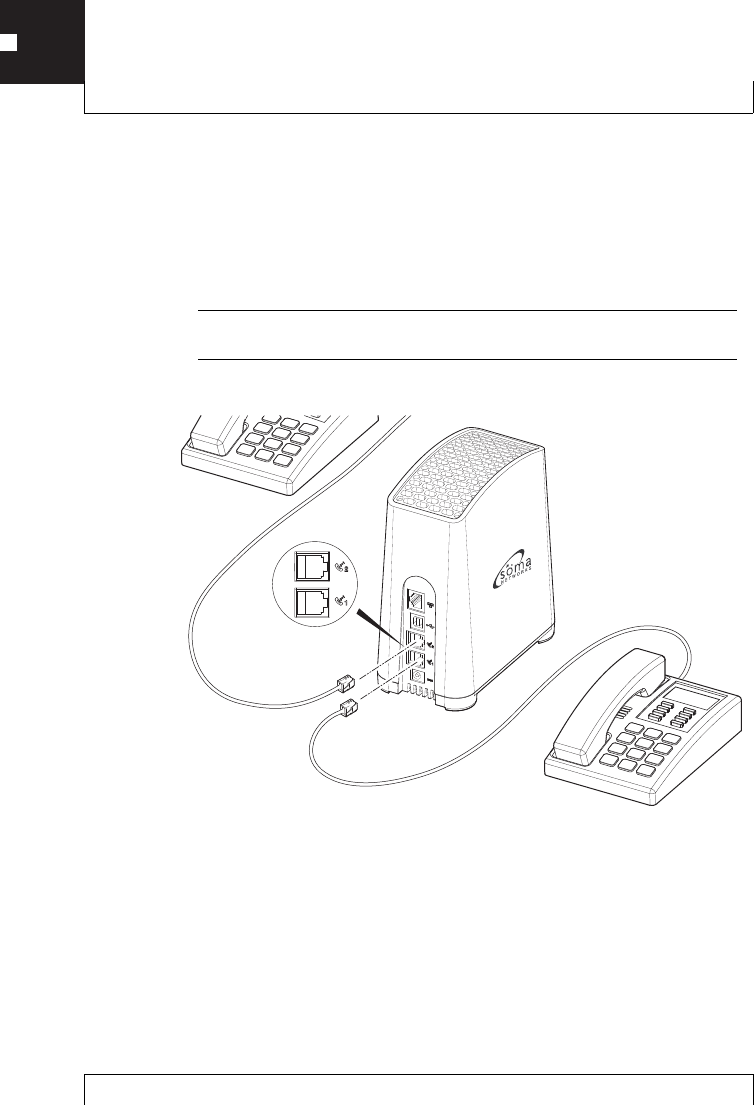
INSTALLING THE SOMAPORT
40
To connect two telephones (when you have two lines)
1Connect the cable of the telephone you want serviced by line 1 to the line 1
(bottom) jack on the SOMAport.
2Connect the cable of the telephone you want serviced by line 2 to line 2 (top) jack
on the SOMAport.
NOTE: If you have a two-line telephone, connect it to the line 1 (bottom)
jack.
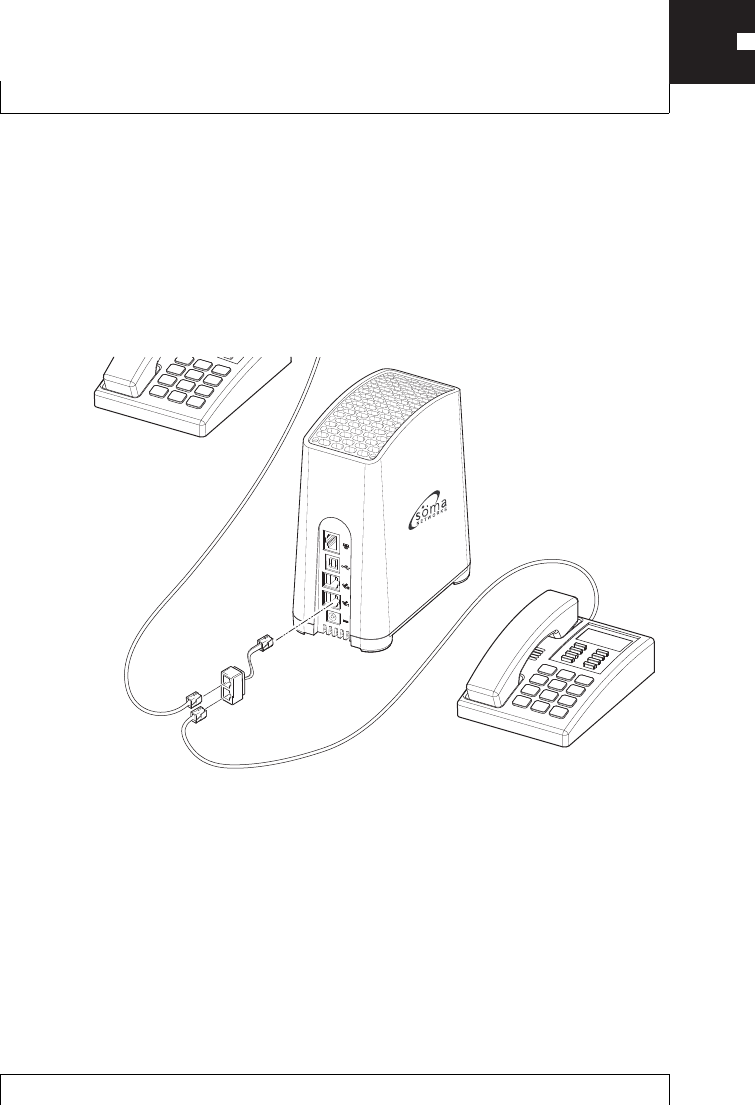
INSTALLING THE SOMAPORT
41
To connect two telephones (when you have one line)
1Insert a dual-jack extension cord or adapter into the line 1 (bottom) jack of the
SOMAport.
2Insert the free end of one telephone cable into one of the jacks on the adapter.
3Insert the free end of the second telephone cable into the other jack on the
adapter.
To test your SOMAport telephone service
Pick up the receiver and listen for dial tone.
If you hear a standard dial tone, the SOMAport is connected to your service
provider’s network. You may have to activate full service if your service provider has
not done so already. See "Activating Service" on page 42.
If you hear a series of tones, the SOMAport is still starting. Hang up, and listen again
in a few minutes.
If you hear silence, see "Finding Causes of Telephone Problems" on page 50.

INSTALLING THE SOMAPORT
42
ACTIVATING SERVICE
After the SOMAport powers on, it will be in one of two service modes:
Restricted access: Your SOMAport remains in this mode
until your account is activated by your service provider. You
can use the SOMAport only to contact your service provider
to activate full service, either by telephone or through the
service provider’s Web site. You cannot receive telephone
calls in this mode, although you can place a call to an
emergency service (for example, 911 in North America).
Full-service access: You can browse any site on the
Internet, receive telephone calls, and place calls to any
telephone number.
To activate full service
1Restart your computer while it is connected to the powered-on SOMAport.
2Launch a Web browser.
3Direct your browser to a known valid Internet address
(such as www.google.com).
If the page opens, full service has already been activated and you can begin
using your SOMAport for Internet service.
If you are redirected to your service provider’s Web page, complete the sign-
up procedure on the Web site to activate full service.
If you can not open any Web pages at all, see "Finding Causes of Computer
Problems" on page 48.
NOTE: If you subscribe only to telephone service, activate full service by
calling your service provider’s assistance center.

43
This chapter explains how to install the SOMAport as an Internet gateway for a
local area network. Follow the procedures in this chapter if you want to connect
multiple computers.
Contents
Overview ............................................................................................. 44
Using an Ethernet Hub ........................................................................ 45
Using an Internet Router ...................................................................... 46
C
ONNECTING
M
ULTIPLE
C
OMPUTERS

CONNECTING MULTIPLE COMPUTERS
44
OVERVIEW
A hub, switch, or router is required in order to share the Internet
connection with multiple computers. The SOMAport functions as a
DHCP server (it automatically assigns IP addresses to devices attached
to it) and will work with most consumer home network devices.
The connection procedure differs slightly depending on the type of your
home network device.
When using a hub or switch, see "Using an Ethernet Hub" on page 45.
When using an Internet router see "Using an Internet Router"
on page 46.

CONNECTING MULTIPLE COMPUTERS
45
USING AN ETHERNET HUB
An Ethernet hub or switch (referred to generically in this section as a
"hub") can be used to have multiple computers share an Internet
connection from a single SOMAport.
NOTE: Each computer connected to the hub requires an IP address
assigned to it by your service provider. Contact your service provider for
information about provisioning an account that can use several IP
addresses.
To use an Ethernet hub with the SOMAport
1Choose a location and power on the SOMAport, as described in chapter
"Connecting the Power Supply and Powering on the SOMAport” on page 32.
2Wait for the SOMAport to find a base station.
3Connect the SOMAport to the hub:
iInsert one end of a straight-through Ethernet cable into the Ethernet port on
the back of the SOMAport.
ii Insert the other end of the cable into an uplink port (sometimes labeled as a
WAN or Internet port) on the hub.
NOTE: If the hub does not have an uplink port, you may connect to the
SOMAport using an Ethernet port (which may be labeled as a switched,
LAN, or numbered port) on the hub. However, you must obtain and use a
crossover Ethernet cable (not shipped with the SOMAport) to make this
connection.
4Power on the hub.
5Connect each computer to an Ethernet port on the hub.
6Reboot each computer.

CONNECTING MULTIPLE COMPUTERS
46
USING AN INTERNET ROUTER
An Internet router, supporting either Ethernet or WiFi (802.11)
connections, can be used to have multiple computers share an Internet
connection from a single SOMAport.
To use an Internet router with the SOMAport
1Choose a location and power on the SOMAport, as described in chapter
"Connecting the Power Supply and Powering on the SOMAport” on page 32.
2Wait for the SOMAport to find a base station.
3Power on the router.
4If necessary, configure the router to use DHCP when obtaining an external IP
address. See the documentation for your router for specific configuration
Information.
5Connect the SOMAport to the router:
iInsert one end of a straight-through Ethernet cable into the Ethernet port on
the SOMAport.
ii Insert the other end of the cable into an uplink port (sometimes labeled as a
WAN or Internet port) on the router.
6Connect each computer to the Internet router. See the documentation for your
router for information.

47
This chapter describes the problems the SOMAport may exhibit, the possible
causes of those problems, and the actions you should take to fix them.
Contents
Finding Causes of Computer Problems ............................................... 48
Finding Causes of Telephone Problems ............................................... 50
The Signal is Weak .............................................................................. 52
There is a Fault Condition .................................................................... 54
The SOMAport is Not Receiving Power ............................................... 55
There is a Problem with the Ethernet or USB Cabling .......................... 56
There is a Problem with the USB Port Settings .................................... 58
The Computer Uses an Old Dial-up Connections ................................ 59
Internet Explorer LAN Settings are Incorrect ........................................ 61
Ethernet Network Settings are Incorrect .............................................. 62
IP Address Needs to be Renewed ....................................................... 72
TROUBLESHOOTING

TROUBLESHOOTING
48
FINDING CAUSES OF COMPUTER PROBLEMS
Look up the problem you are experiencing and follow the suggested
actions. If the recommended actions do not fix the problem, contact
your service provider.
Problem Possible causes Action
You cannot
connect to the
Internet
Network settings for an
Ethernet connection are
incorrect.
See "Ethernet Network settings
are Incorrect" on page 62.
Signal has been dropped. Unplug the SOMAport and plug
it back in again.
The SOMAport is not
receiving power. See "The SOMAport is Not
Receiving Power" on page 55.
The SOMAport experienced
a fault condition during
startup.
See "There is a Fault Condition"
on page 54.
No connection between the
computer and the
SOMAport.
See "There is a Problem with
the Ethernet Cabling" on page
56.
You are using Internet
Explorer and the LAN
settings are not properly
configured.
See "Internet Explorer LAN
Settings are Incorrect" on page
61.
Signal is weak. See "The Signal is Weak" on
page 52

TROUBLESHOOTING
49
It takes a long
time to open a
Web page
Internet congestion. Try again.
Signal is weak. See "The Signal is Weak" on
page 52.
Cable connecting the
computer to the SOMAport
is damaged.
Replace the cable.
It takes a long
time to open a
Web page
Your Ethernet interface is in
full-duplex mode.
(This applies only if your
SOMAport is directly
connected to the Ethernet
port on your computer,
rather than through a hub.)
Use the appropriate system
control to change the duplex
setting of your Ethernet port to
half-duplex. Refer to the
documentation for your
operating system.
Making a
wireless
Internet
connection is
prevented by
old dial-up
default
Computer is set up to
connect to the Internet via
dial-up by default.
See "The Computer Uses an
Old Dial-UP Connection" on
page 59.
You cannot
send Email SMTP server associated
with your existing email
account is not accessible.
Use a Web account, such as
Yahoo, for sending and
receiving messages.
Problem Possible causes Action

TROUBLESHOOTING
50
FINDING CAUSES OF TELEPHONE PROBLEMS
Look up the problem you are experiencing and follow the suggested
actions. If the recommended actions do not fix the problem, call your
service provider.
Problem Possible causes Action
Irregular dial
tone If you hear a series of tones
(not a regular dial tone)
before you attempt a call,
the SOMAport has not yet
acquired a signal.
Wait a few minutes and try
again.

TROUBLESHOOTING
51
No dial tone If you hear a "fast busy"
tone after you attempt to
dial a number, you have not
yet acquired a signal.
Activate full service as
described in "Activating
Service" on page 42.
If your telephone is
connected to line 2 and you
hear silence before dialing a
call, you are in restricted
mode.
Activate full service as
described in "Activate Service"
on page 42.
Cable connections are not
secure. Make sure the telephone cable
is securely connected to the
SOMAport and the telephone.
Telephone cable is inserted
into the SOMAport’s
Ethernet port
Make sure that the telephone is
connected to a telephone jack.
Telephone is broken. Try a telephone that is known
to work. If you were using a
cordless telephone, try using a
corded one.
SOMAport experienced a
fault condition during
startup.
See "There is a Fault Condition"
on page 54.
SOMAport is not receiving
power. See "The SOMAport is not
Receiving Power" on page 55.
No dial tone Signal is weak. See "The Signal is Weak" on
page 52.
Voice quality is
poor Signal is weak. See "The Signal is Weak" on
page 52.
Telephone is broken. Try a telephone that is known
to work. If you were using a
cordless telephone, try using a
corded one.
Calls are
dropped Signal is weak. See "The Signal is Weak" on
page 52.
Problem Possible causes Action

TROUBLESHOOTING
52
THE SIGNAL IS WEAK
The signal to your SOMAport may be weak if you are having any of the
following problems:
Telephone voice quality is poor or calls are dropped.
It takes a long time to open a Web page.
You cannot browse the Internet at all.
To improve reception quality
If you are experiencing an outgoing performance problem, try the following steps:
1Make sure you have located the SOMAport according to the guidelines listed in
“Choose the Best Location” on page 31.
2See if a nearby appliance is disrupting the signal. Do the following for each
appliance, testing one appliance at a time:
iTurn off the appliance.
ii While the appliance is off, check if the network performance improves.
If there is an improvement, reposition either the appliance or the
SOMAport so that they are further apart.
If there is no improvement, turn the appliance back on and try another
appliance.
3If you cannot improve reception in the SOMAport’s current location, try moving it
to another location that meets the guideline on page 31.

TROUBLESHOOTING
53
Persistent Reception Difficulties
Reception can be temporarily affected by severe weather conditions
such as heavy storms, ice, or strong winds. Problems may persist in
the absence of these conditions if:
There are obstructions – tall buildings, trees, or mountains
– between your SOMAport and the nearest
communications tower.
Your SOMAport is located at the outer limit of the
coverage area.
Contact your service provider if you experience persistent signal
reception difficulties.

TROUBLESHOOTING
54
THERE IS A FAULT CONDITION
This section describes how to restart the SOMAport. If the status light
is red, the SOMAport has detected a fault. In this situation, restart the
SOMAport. Also, if you cannot solve a problem with any of the
procedures above, try restarting.
To restart SOMAport
1Unplug the SOMAport from the wall power outlet and leave it off for at least 10
seconds.
2Plug the SOMAport back in.
Wait until the status light on the front panel is green, which indicates that the
SOMAport is receiving a radio signal.
If the problem is not solved, please call your service provider.

TROUBLESHOOTING
55
THE SOMAPORT IS NOT RECEIVING POWER
If the light on the power supply and the status light on the SOMAport
are off, the SOMAport is not receiving power. Try each of the actions in
the following procedure until you locate the source of the problem.
To check the power
1Make sure the power cord which connects the power supply to the wall outlet is
securely connected to the power supply and the wall outlet.
2Make sure the power cord which connects the power supply to the SOMAport is
securely connected to the power jack on the back of the SOMAport.
3Make sure the wall receptacle is working by plugging in an appliance which you
know works.
4Check the circuit breaker.
5If you cannot find the source of the problem, call your service provider.

TROUBLESHOOTING
56
THERE IS A PROBLEM WITH
THE ETHERNET OR USB CABLING
If there is a problem with the physical connection between the
SOMAport and your computer or hub, you will not be able to browse
the Internet.
Ethernet connection
There are two lights on the Ethernet port that indicate the status of the
Ethernet connection: link (green), and data transmit (amber).
If the link light is off, the connection between the SOMAport and the
Ethernet device is not working or does not exist.
The data transmit light flashes when data is being transmitted across
the link. It is normal for this light to be off much of the time.
To check Ethernet cabling
1Make sure the cable connectors are firmly inserted in the appropriate Ethernet
ports on the SOMAport and computer or hub.
2Make sure you are using the correct type of cable:
3Make sure the length of the cable does not exceed 50 meters (167 feet).
4If none of the previous steps solves the problem, replace the cable.
NOTE: You can replace the cable while the SOMAport is on.
Configuration Cable Type Provided
Ethernet port of a computer Straight-through Yes
Uplink port of a hub Straight-through Yes
Ethernet port of a hub Crossover No

TROUBLESHOOTING
57
USB connection
There is no link light on the USB port. If you are using USB to connect
your computer to the SOMAport and you suspect there is a problem
with the physical connection, check the USB cabling.
To check USB cabling
1Make sure the cable connectors are firmly inserted in the appropriate USB ports
on the SOMAport and the computer or hub.
2Make sure the length of the cable does not exceed 5 meters (15 feet).
3If you are using a USB extension cable, check to see if it is faulty by removing the
USB extension and using a single USB cable between the SOMAport and the
computer.
You may have to reposition the SOMAport to do this.
4Replace the USB cable.
You can replace the cable while the SOMAport is on.

TROUBLESHOOTING
58
THERE IS A PROBLEM WITH
THE USB PORT SETTINGS
If you are having problems getting the USB connection to work, ensure
that your computer’s USB port is enabled and properly set up.
To check your PC’s USB port settings
1Open the Control Panel:
In Windows 98 and 2000 and ME, choose Start → Settings
→ Control Panel.
In Windows XP, choose Start → Control Panel.
2Double-click the System icon.
3Open the Device Manager:
In Windows 98 and ME, click the Device Manager tab.
In Windows 2000 or XP, click the Hardware tab and then click the Device
Manager button.
4Display devices by type:
In Windows 95 and 98 and ME, make sure the View devices by type radio
button is enabled.
In Windows 2000 and XP, select View → Devices by type.
5Click the plus (+) icon next the Universal Serial Bus controller option. If the
following drives are listed, USB is enabled and you can use the USB port:
USB Host Controller
USB Root Hub
If these drives are not listed, there are two possible reasons:
You have a USB Host Controller installed in your PC, but the USB port is not
enabled. See your computer’s documentation for instructions on how to run
your computer’s BIOS Setup program to enable the USB port.
You do not have a valid USB Host Controller installed in your PC. You cannot
use USB until you install a valid USB Host Controller.

TROUBLESHOOTING
59
THE COMPUTER USES
AN OLD DIAL-UP CONNECTIONS
If you have switched from a dial-up Internet service when you
subscribed to wireless SOMAport Internet service, you may still be
prompted to connect to the Internet using the old dial-up connection. If
this is the case, follow this procedure to ensure that your dial-up
connection is not automatically activated whenever you attempt the
Internet connection.
To disable the automatic dial-up connection in Windows
1Open the Control Panel.
In Windows XP – Choose Start → Control Panel.
In all other versions of Windows – Choose Start → Settings
→ Control Panel.
2Double-click the Internet Options icon.
The Internet Properties window opens.
3Click the Connections tab.
4Enable the Never dial a connection checkbox.
5Click OK.
NOTE: If you are still unable to display a Web page, check your browser to
make sure it is in online mode.
To disable the automatic dial-up connection in Mac OS 8 and 9
1Click the Apple icon and choose Control Panels.
2Click Remote Access.
3Click Options.
4Click the Protocol tab.

TROUBLESHOOTING
60
5Make sure the Connect automatically when starting TCP/IP applications
box is disabled.
6Click OK.
7Choose File → Quit.
8Click Save when prompted to save the current configuration.
To disable the automatic dial-up connection in Mac OS X
1Click the Apple icon and choose System Preferences.
2Click the Network icon.
3Click Show.
4Select Network Port Configurations from the pull-down list.
5Disable the On checkbox for the dial-up modem.
6Click Apply Now.

TROUBLESHOOTING
61
INTERNET EXPLORER LAN SETTINGS
ARE INCORRECT
If you are using Internet Explorer as your Web browser, make sure it is
configured to automatically detect LAN settings. If this default setting
has been disabled, you will not be able to connect to the Internet.
To check Internet Explorer settings
1Open Internet Explorer.
2Choose Tools → Internet Options.
The Internet Options window opens.
3Click the Connections tab.
4Click LAN Settings.
The Local Area Network (LAN) Settings window opens.
5Make sure the Automatically detect settings checkbox is enabled.
6Click OK.
7Click OK on the Internet Options window.
8Close Internet Explorer.

TROUBLESHOOTING
62
ETHERNET NETWORK SETTINGS
ARE INCORRECT
If you could not establish an Internet connection after connecting your
computer to the SOMAport via Ethernet, but your physical connection
seems to be intact, your computer’s Ethernet network settings may
need to be changed.
Use the procedure in this section appropriate to your operating system
to reconfigure Ethernet network settings. You may be prompted to
insert the installation CD for your operating system, and you may need
to reboot your computer after changing the settings before you can
successfully connect to the Internet.
To change network settings in Windows 95
1Choose Start → Settings → Control Panel.
2Double-click the Network icon.
The Network window opens to the Configuration tab.
3Select TCP/IP.
If multiple TCP/IP connections are listed, select the one that contains
"Ethernet", "NIC", or "10/100 MB" in its name, go to step 5.
If TCP/IP is not listed, go to step 4.
4Install TCP/IP:
iClick Add.
The Select Network Component Type window opens.
ii Select Protocol from the list.
iii Click Add.
The Select Network Protocol window opens.
iv Select Microsoft from the Manufactures list.
vSelect TCP/IP from the Network Protocols list.
vi Click OK.

TROUBLESHOOTING
63
vii Insert the Windows 95 CD or reboot the computer if prompted to do so.
viii If the PC reboots, repeat steps 1 to 3, then go to step 5.
5Check the TCP/IP properties:
iClick Properties.
The TCP/IP Properties window opens to the IP Address tab.
ii Make sure the Obtain an IP address automatically radio button
is enabled.
iii Click the DNS Configuration tab.
iv Enable the Disable DNS radio button.
vClick OK on the TCP/IP Properties window.
vi Click OK on the Network window.
vii Restart the computer if prompted to do so.
6Check your Internet connection by launching a Web browser on the computer
connected to the SOMAport.
If your browser automatically opens to your service provider’s Web site,
activate full service by following the sign-up procedure that is provided on the
Web site.
If your browser does not automatically open to your service provider’s Web
site, go to step 7.
7Enter a valid Internet address (such as www.google.com) in the Address field.
If the Web page opens, full service has already been activated and you can
begin using your SOMAport for Internet service.
If your service provider’s Web page opens, activate full service by following
the sign-up procedure that is provided on the Web site.
If your computer attempts to connect to the Internet using an old dial-up
connection, see "The Computer Uses an Old Dial-Up Connection" on page
59.
If you do not get an Internet connection, see "Finding Causes of Computer
Problems" on page 48.

TROUBLESHOOTING
64
To change network settings in Window 98 and ME
1Choose Start → Settings → Control Panel.
2Click the Network icon.
The Network window opens to the Configuration tab.
3Select TCP/IP.
If multiple TCP/IP connections are listed, select the one that contains
"Ethernet", "NIC", or "10/100 MB" in its name, go to step 4.
If TCP/IP is not listed, install it:
iClick Add.
The Select Network Component Type window opens.
ii Select Protocol from the list.
iii Click Add.
The Select Network Protocol window opens.
iv Select Microsoft from the Manufacturers list.
vSelect TCP/IP from the Network Protocols list.
vi Click OK.
vii Insert the Windows 98 or ME CD or reboot the computer if prompted to do
so.
viii If the PC reboots, repeat steps 1 to 3.
4Check TCP/IP properties:
iClick Properties with the correct TCP/IP connection selected.
The TCP/IP Properties window opens to the IP Address tab.
ii Make sure the Obtain an IP address automatically radio button
is enabled.
iii Click the DNS Configuration tab.
iv Make sure the Disable DNS radio button is enabled.
vClick OK on the TCP/IP Properties window.
vi Click OK on the Network window.
vii Restart the computer if prompted to do so.
5Check your Internet connection by launching a Web browser on the computer
connected to the SOMAport.

TROUBLESHOOTING
65
If your browser automatically opens to your service provider’s Web site, full
service has already been activated and you can begin using your SOMAport
for Internet service.
If your browser does not automatically open to your service provider’s Web
site, go to step 6.
6Enter a valid Internet address (such as www.google.com) in the Address field
and press Enter.
If the Web page opens, full service has already been activated and you can
begin using your SOMAport for Internet service.
If your service provider’s Web page opens, activate full service by following
the sign-up procedure that is provided on the Web site.
If your computer attempts an Internet connection using an old dial-up
connection, see "The Computer Uses an Old Dial-Up Connection" on page
59.
If you do not establish an Internet connection, see "Finding Causes of
Computer Problems" on page 48.

TROUBLESHOOTING
66
To change network settings in Windows 2000
1Right-click the My Network Places icon and choose Properties from the pull-
down menu.
The Network and Dial-up Connections window opens.
2Select the Local Area Connection icon.
If there are multiple local area connections, read the device name beside
each icon and double-click the one that is associated with the Ethernet card.
If there is no icon, the Ethernet card has not been properly installed. Install
the Ethernet card by following the manufacturer’s instructions, then return to
this procedure.
The Local Area Connection Status window opens.
3Click Properties.
The Local Area Connection Properties window opens.
4Select Internet Protocol (TCP/IP).
If Internet Protocol (TCP/IP) is not listed, install it as follows:
iClick Install.
The Select Network Component Type window opens.
ii Select Protocol from the list.
iii Click Add.
The Select Network Protocol window opens.
iv Select Internet Protocol (TCP/IP).
vClick OK.
vi Insert the Windows 2000 CD or reboot the computer if prompted to do so.
vii If the PC reboots, repeat steps 1 to 4.
5Check TCP/IP properties:
iClick Properties.
ii The Internet Protocol (TCP/IP) Properties window opens to the General tab.
iii Make sure the Obtain an IP address automatically radio button
is enabled.
iv Make sure the Obtain DNS server address automatically radio button
is enabled.

TROUBLESHOOTING
67
vClick OK on the Internet Protocol (TCP/IP) Properties window.
vi Click OK on the Local Area Connection Properties window.
vii Click Close on the Local Area Connection Status window.
viii Restart the computer if prompted to do so.
6Check your Internet connection by launching a Web browser on the computer
connected to the SOMAport.
If your browser automatically opens to your service provider’s Web site, full
service has already been activated and you can begin using your SOMAport
for Internet service.
If your browser does not automatically open to your service provider’s Web
site, go to step 7.
7Enter a valid Internet address (such as www.google.com) in the Address field
and press Enter.
If the Web page opens, full service has already been activated and you can
begin using your SOMAport for Internet service.
If your service provider’s Web page opens, activate full service by following
the sign-up procedure that is provided on the Web site.
If your computer attempts to connect to the Internet using an old dial-up
connection, see "The Computer Uses an Old Dial-Up Connection" on page
59.
If you do not get an Internet connection, see "Finding Causes of Computer
Problems" on page 48.

TROUBLESHOOTING
68
To change network settings in Windows XP
1Choose Start → Settings → Network Connections.
The Network Connections window opens.
2Select the Local Area Connection icon.
If there are one or more Local Area Connection icons, double-click the Local
Area Connection icon that is associated with the Ethernet card.
If there is no icon, the Ethernet card has not been properly installed. Install
the Ethernet card by following the manufacturer’s instructions, then return to
this procedure.
The Local Area Connection Status window opens.
3Click Properties.
The Local Area Connection Properties window opens.
4Select Internet Protocol (TCP/IP).
If Internet Protocol (TCP/IP) is not listed, install it as follows:
iClick Install.
The Select Network Component Type window opens.
ii Select Protocol from the list.
iii Click Add.
The Select Network Protocol window opens.
iv Select Internet Protocol (TCP/IP).
vClick OK.
vi Insert the Windows XP CD or reboot the computer if prompted to do so.
vii Once TCP/IP has been installed, repeat steps 1 to 4.
5Check TCP/IP properties:
iClick Properties.
The Internet Protocol (TCP/IP) Properties window opens to the General tab.
ii Make sure the Obtain an IP address automatically radio button
is enabled.
iii Make sure the Obtain DNS server address automatically radio button
is enabled.
iv Click OK on the Internet Protocol (TCP/IP) Properties window.

TROUBLESHOOTING
69
vClick OK on the Local Area Connection Properties window.
vi Click Close on the Local Area Connection Status window.
vii Restart the computer if prompted to do so.
6Check your Internet connection by launching a Web browser on the computer
connected to the SOMAport.
If your browser automatically opens to your service provider’s Web site, full
service has been activated.
If your browser does not automatically open to your service provider’s Web
site, go to step 6.
7Enter a valid Internet address (such as www.google.com) in the Address field
and press Enter.
If the Web page opens, full service has already been activated and you can
begin using your SOMAport for Internet service.
If your service provider’s Web page opens, activate full service by following
the sign-up procedure that is provided on the Web site.
If your computer attempts an Internet connection using an old dial-up
connection, see "The Computer Uses an Old Dial-Up Connection" on page
59.
If you do not get an Internet connection, see "Finding Causes of Computer
Problems" on page 48.

TROUBLESHOOTING
70
To change network settings in Mac OS 8 and 9
NOTE: Your computer must have an Ethernet card and Open Transport
networking software to connect to the Internet.
1Click the Apple icon and choose Control Panels > TCP/IP.
The TCP/IP window opens.
2Select Ethernet from the Connect via pop-up menu.
3Select Using DHCP Server from the Configure pop-up menu.
4Close the TCP/IP control panel.
If you made any changes, save them when prompted.
5Restart your computer.
6Check your Internet connection by launching a Web browser on the computer
connected to the SOMAport.
If your browser automatically opens to your service provider’s Web site, full
service has already been activated.
If your browser does not automatically open to your service provider’s Web
site, go to step 7.
7Enter a valid Internet address (such as www. google.com) in the Address field
and press enter.
If the Web page opens, full service has already been activated and you can
begin using your SOMAport for Internet service.
If your service provider’s Web page opens, activate full service by following
the sign-up procedure that is provided on the Web site.
If you do not establish an Internet connection, see "Finding Causes of
Computer Problems" on page 48.

TROUBLESHOOTING
71
To change network settings in Mac OS X
1Click the Apple icon and choose System Preferences.
2Choose View → Network.
3Choose Built-in Ethernet from the Show pop-up menu.
4Click the TCP/IP tab, if necessary.
5Choose Using DHCP from the Configure pop-up menu.
6Click Apply Now.
7Restart your computer.
8Check your Internet connection by launching a Web browser on the computer
connected to the SOMAport.
If your browser automatically opens to your service provider’s Web site, full
service has already been activated.
If your browser does not automatically open to your service provider’s Web
site, go to step 6.
9Enter a valid Internet address (such as www.google.com) in the Address field
and press Enter.
If the Web page opens, full service has already been activated and you can
begin using your SOMAport for Internet service.
If your service provider’s Web page opens, activate full service by following
the sign-up procedure that is provided on the Web site.
If you do not establish an Internet connection, see "Finding Causes of
Computer Problems" on page 48.

TROUBLESHOOTING
72
IP ADDRESS NEEDS TO BE RENEWED
If you cannot connect to the Internet even after you have checked all
cabling and network settings and have rebooted the computer, follow
the appropriate procedure in this section to manually obtain a new IP
address.
To obtain a new IP address (Windows 95 only)
1Choose Start → Run.
2Enter winipcfg in the Open field and click OK.
The IP Configuration window opens.
3Select the network interface that has a default gateway of 192.168.1.1 from the
pull-down list.
4Click Release All.
5Force your computer to obtain a new IP address by clicking Renew All.
Wait until the fields in the IP Configuration window have values in them or an error
message appears. If you close this program before it has completed its task, you
will have to reboot your computer before you can use your Internet service.
6Close the IP Configuration window.

TROUBLESHOOTING
73
To obtain a new IP address (all other versions of Windows)
1Open a command window using one of the following methods:
In Windows 2000 or XP, choose
Start → Programs → Accessories → Command Prompt.
In Windows 98 or ME, choose Start → Programs → MS-DOS Prompt.
The command window opens.
2Force your computer to obtain a new IP address by typing the appropriate
command from the following table:
The Windows IP configuration is displayed.
3Look for the output section related to the network interface for the SOMAport.
Example:
Ethernet adapter:
IP address............. : 65.94.64.233
Subnet Mask............ : 255.255.255.0
Default Gateway........ : 192.168.1.1
4Close the MS-DOS Prompt or Command Prompt window.
Operating System Command
Windows 98 or ME ipconfig /renew_all ↵
Windows 2000 or XP ipconfig /renew ↵

TROUBLESHOOTING
74

75
Release SOMAport 400
Internal antenna Type: internal passive-steered array antenna
Internal antenna gain: 3.0 dBi
Receiver noise figure: 6.0 dB
Transmitted EIRP: 30 dBm
RF output power: 27 dBm
Device ports and
Interfaces Ethernet: 100BASE-T (RJ-45)
USB: USB 1.1 (optional)
Telephone: Telephone terminal interface (RJ-11 jacks) (2)
AC Adapter: Coaxial DC Power Jack, 12V/30W
Lights Status, Network
Power
Requirements Power Supply:
Type: U.S./International 100/240V AC-DC external power supply
Cable: Power cord with non-wall-mounted AC-to-DC transformer
Environmental
Specifications Temperature:
Operating: 5°C to 40°C (+46°F to +104°F)
Storage: –20 °C to 60 °C (–4°F to 140°F)
Humidity:
Operating: 20% to 95%, non-condensing
Storage: 5% to 95%, non-condensing
Packaging Dimensions
Height: 172 mm (6.8 inches)
Width: 150 mm (5.9 inches)
Depth: 82 mm (3.2 inches)
Weight: 1.0 kg (2.2 pounds)
Volume: 2100 cc
Regulatory
Certifications Radio/EMC
ETSI EN 301 753
ETSI EN 301 489-1
ETSI EN 301 489-4
ETSI EN 300 386
EN 55022:1998+A1:2000+A2:2003 (Class B)
FCC Part 15B, Part 24 (PCS only), Part 27 (700MHz and WCS only)
Safety
MET (Complies with UL 60950-1, CSA C22.2 No. 60950-1)
IEC/EN60950-1
SPECIFICATIONS

SPECIFICATIONS
76

77
A
activating service .................................42
antenna .................................................75
C
cables
crossover ......................................34
Ethernet ........................................34
callsare dropped ...........................51, 52
computer equipment
connecting to a SOMAport
using the Ethernet port
.....................26, 34, 45
connecting
an Ethernet hub ...........................45
computer equipment
using the Ethernet port
.....................26, 34, 45
multiple computers ...............43, 46
telephones ...................................40
connecting telephones .......................37
D
dial tone
no ..................................................41
dial-up connection ..............................59
E
Ethernet
cables ...........................................34
network settings
Mac OS 8 and 9 ..................70
Mac OS X .............................71
Windows 2000 ....................66
Windows 95 .........................62
Windows 98 or ME .............64
Windows XP ........................68
port ...............................................34
F
fault conditions ....................................54
full service
activating ................................41, 63
H
hub. See Ethernet and LANs
I
Internet
access problems .........................49
cannot connect to .......................72
disabling dial-up connection ......59
Internet Explorer
LAN settings are incorrect .........61
IP address
obtaining automatically
Windows 2000 ....................73
INDEX

INDEX
78
Windows 95 .........................72
Windows 98 and ME ..........73
Windows XP ........................73
J
jacks. See telephone jacks and power
jack
L
LANs
Internet Explorer settings incorrect
.........................................61
M
Mac OS
dial-up connection ......................59
network settings ....................70, 71
N
network settings
changing
Mac OS 8 and 9 ..................70
Mac OS X .............................71
Windows 2000 ....................66
Windows 95 .........................62
Windows 98 and ME ..........64
Windows XP ........................68
P
performance .........................................14
ports
Ethernet ........................................26
power jack ......................................32, 55
power requirements ............................75
power supply
check ............................................55
connecting ...................................32
powering on the SOMAport ...............32
problems
Internet connection .....................49
R
reception quality ..................................52
restart
computer ..............63, 64, 67, 69, 71
SOMAport ....................................54
restricted access .................................42
S
safety instructions ...............................11
separation distance .............................27
service modes .....................................42
service providers ...............22, 27, 32, 37
services
activating ......................................42
servicing ...............................................14
settings
Internet Explorer ..........................61
signals
reception ......................................52
strength ........................................52

INDEX
79
SOMAport
performance problems ...............52
restarting ......................................54
SOMAports
connecting Ethernet hubs ..........45
maintenance and servicing ........14
powering on .................................32
signal strength .............................52
T
telephone
poor voice quality ........................51
telephone calls
dropped ........................................51
telephone jacks ...................................26
test telephone service ........................41
two-line telephones .......................39, 40
V
voice quality ...................................51, 52
W
warnings ...............................................11
Web pages ...........................................42
Window 98
network settings ..........................64
Windows 2000
network settings ..........................66
Windows 95
network settings ..........................62
Windows XP
network settings ..........................68
wireless service provider ....................22

INDEX
80